Jasper National Park is one of the largest parks in the Canadian Rockies. Located in the northern part of the Rocky Mountains within Alberta Province, it lies to the north of Banff National Park and west of Edmonton. The park features spectacular attractions like Medicine Lake, Pyramid Lake, Maligne Lake, and Maligne Canyon, where lakes and mountains blend harmoniously to showcase nature’s breathtaking artistry. The park also contains vast, ancient ice fields that attract visitors from around the world. Additionally, it is home to one of the world’s renowned Dark Sky Preserves, hosting an annual Dark Sky Festival each October.
Personally, I find Jasper National Park more appealing than Banff. It offers a more serene atmosphere, diverse landscapes, and a much higher chance of spotting wildlife. While driving, it’s easy to spot animals—just look for clusters of parked cars, a clear signal that there’s wildlife nearby. Fewer crowds and a more varied scenery make Jasper my top choice over Banff.
Mount Robson Park
Driving from Kamloops along Highway 5 and transitioning onto the scenic Highway 16 (the Yellowhead Highway) takes a little over three hours, leading to the towering peak of Mount Robson—the highest mountain in the Canadian Rockies. Although the distance is considerable, the journey itself is a visual treat, with breathtaking views of mountains, lakes, forests, and blooming meadows, which work wonders to melt away fatigue.
Unfortunately, rain greeted us upon arrival at Robson Park, cutting our visit short. After a brief rest, we hit the road again. However, less than 20 minutes later, as we neared Jasper, the skies cleared up, reminding us how quickly weather can change in the mountains. Had the weather been more cooperative, we would have explored the park more thoroughly—it would have made for an excellent stopover along the way.
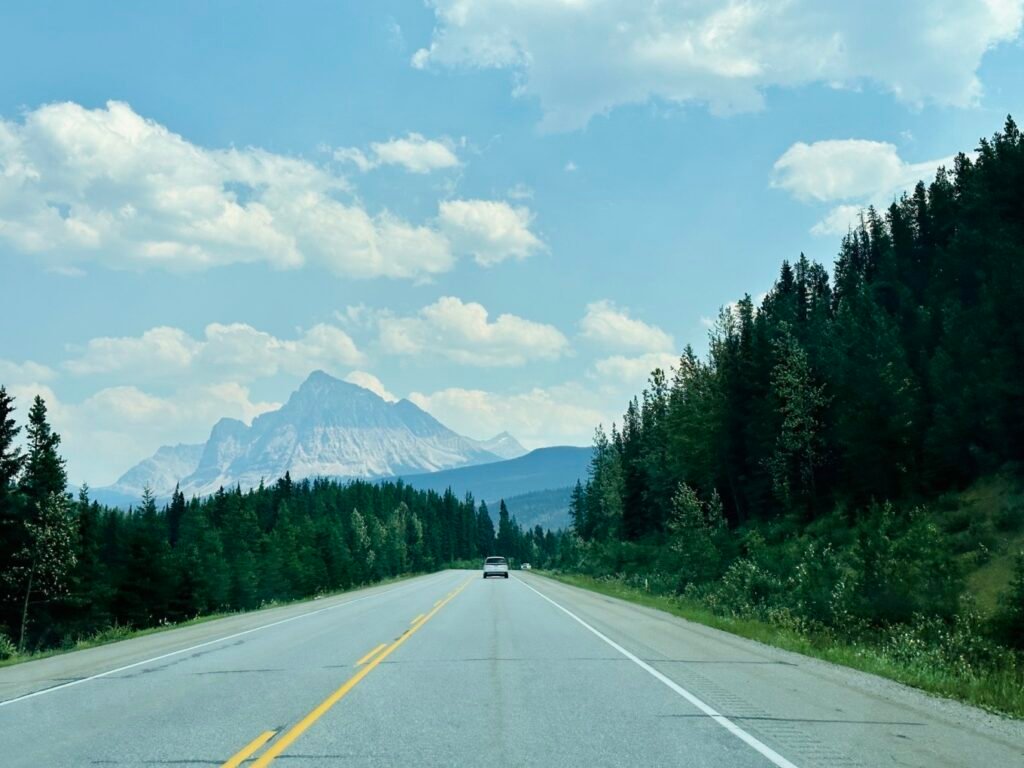
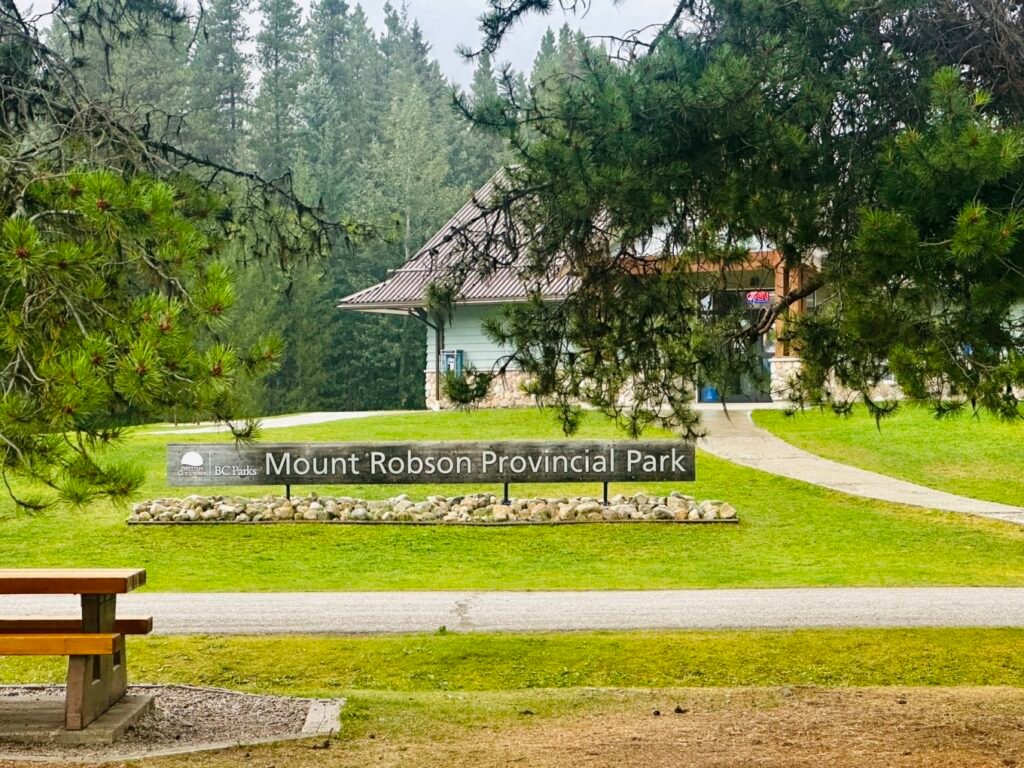
Fairmont Jasper Park Lodge
I had a great impression of the Fairmont resort. It covers a large area, almost like a big park, with beautiful scenery wherever you go. It’s the perfect place to slow down and unwind. The resort has its own private entrance, which not only ensures guests’ privacy and safety but also offers a wide range of recreational activities.
After checking in at the lobby, we headed straight to our room. We booked a standard Fairmont room, but when we opened the curtains, we were greeted by peaceful forest trails and reflections of the surrounding mountains on the water. It was such a refreshing and calming view. After a brief rest, we began wandering around this “grand garden,” exploring everything it had to offer.
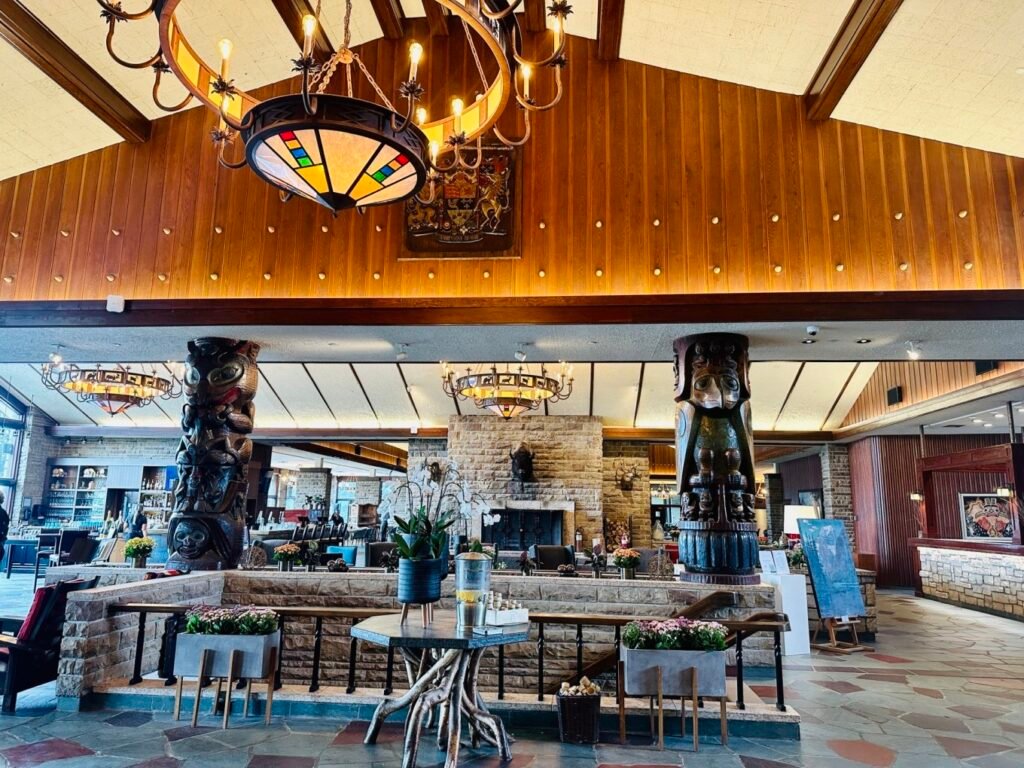
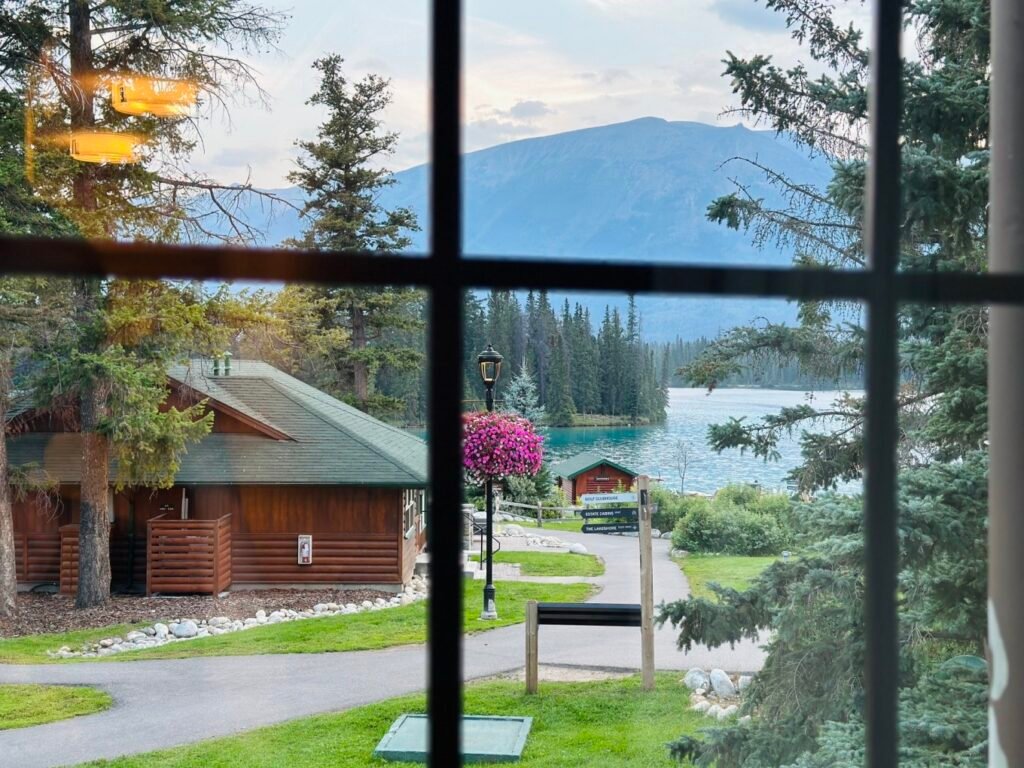
Pyramid Lake
Since we had a dinner reservation at 6 PM and still had some time to kill, we decided to take a walk around Pyramid Lake. This lake is famous mainly because there aren’t many tall trees around it, and the shallow waters near the shore reflect the dense pine forests at the base of the mountains, creating a scene that looks like a beautiful painting.
However, when we visited around 4 PM, we missed out on that stunning reflection. If you want to catch it, you’ll need to go early in the morning, preferably before sunrise. Even though we didn’t get to see the famous reflection, sitting on one of those iconic red chairs and enjoying the lake breeze in the August weather was still a wonderfully peaceful experience.
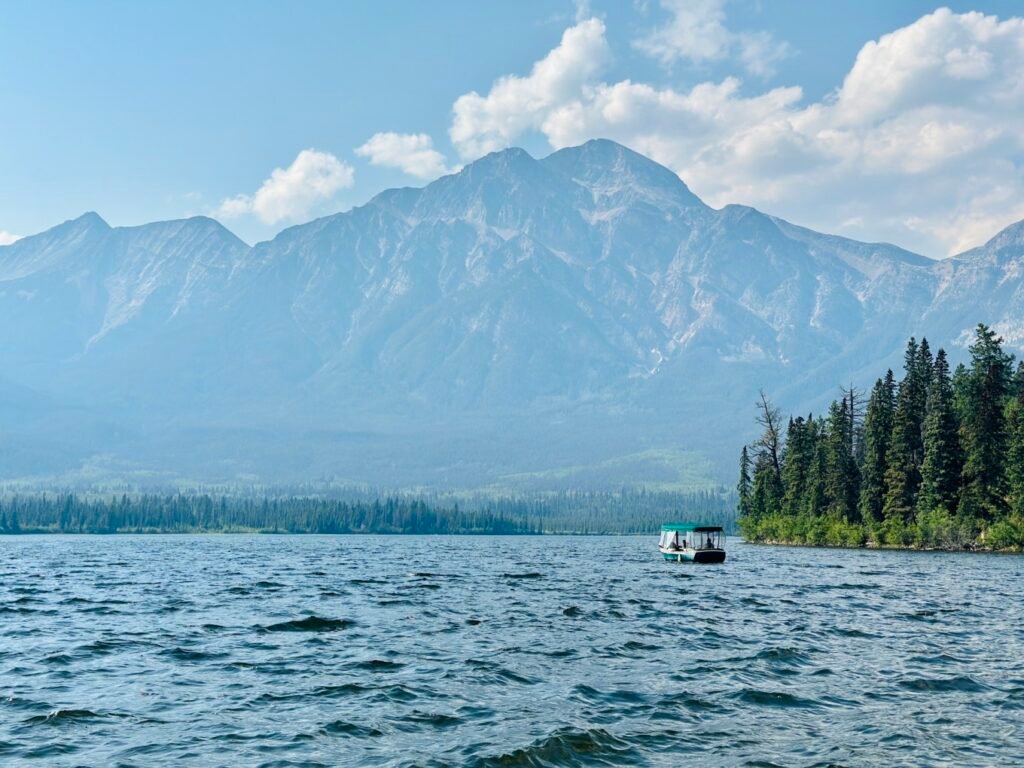
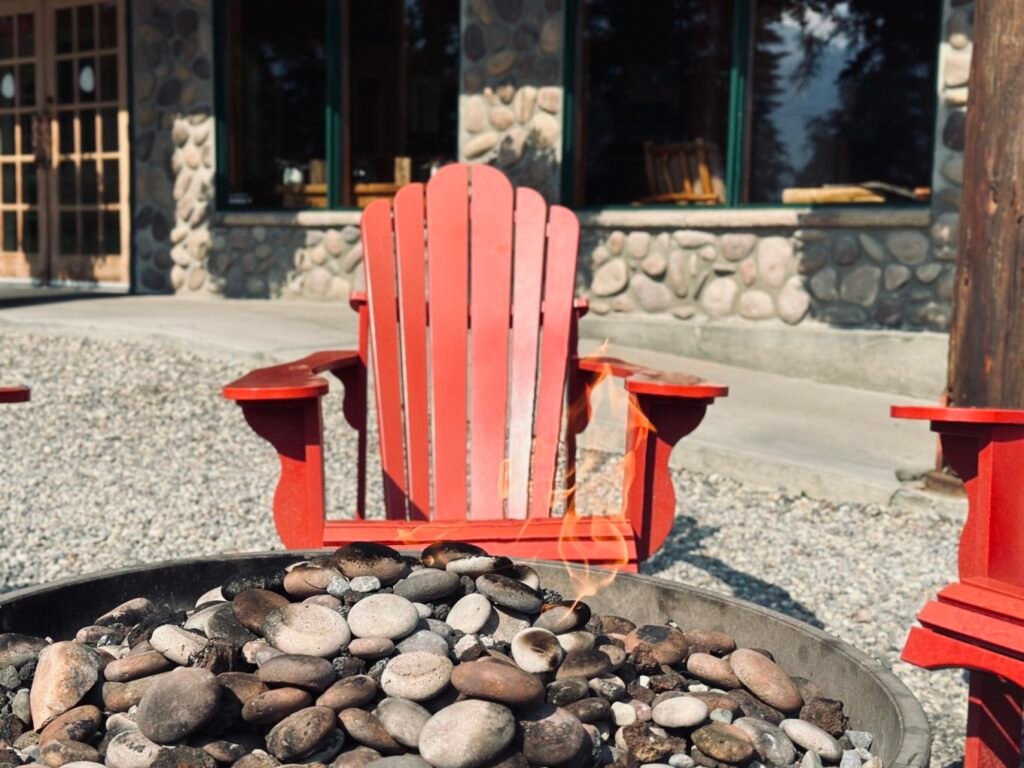
The Raven Bistro – A Mediterranean Restaurant
It only took about 10 minutes to drive from Pyramid Lake to the town of Jasper, where we found some time-limited free parking along the street. After parking, we strolled around town for a bit. The streets were lively and well-kept, with colorful buildings adding charm to the town. A few of the churches we passed were over a hundred years old, giving the place a sense of history.
We had made a reservation at a highly-rated Mediterranean restaurant to avoid disappointment, but we went in with low expectations, just in case. We ordered a surf and turf platter, a fish and rice bake with sauce, and a chocolate walnut cake. To our surprise, everything was delicious! 😋 The rave reviews were well deserved. The place was busy, so if you don’t have a reservation, you probably won’t get a table. Definitely worth checking out!
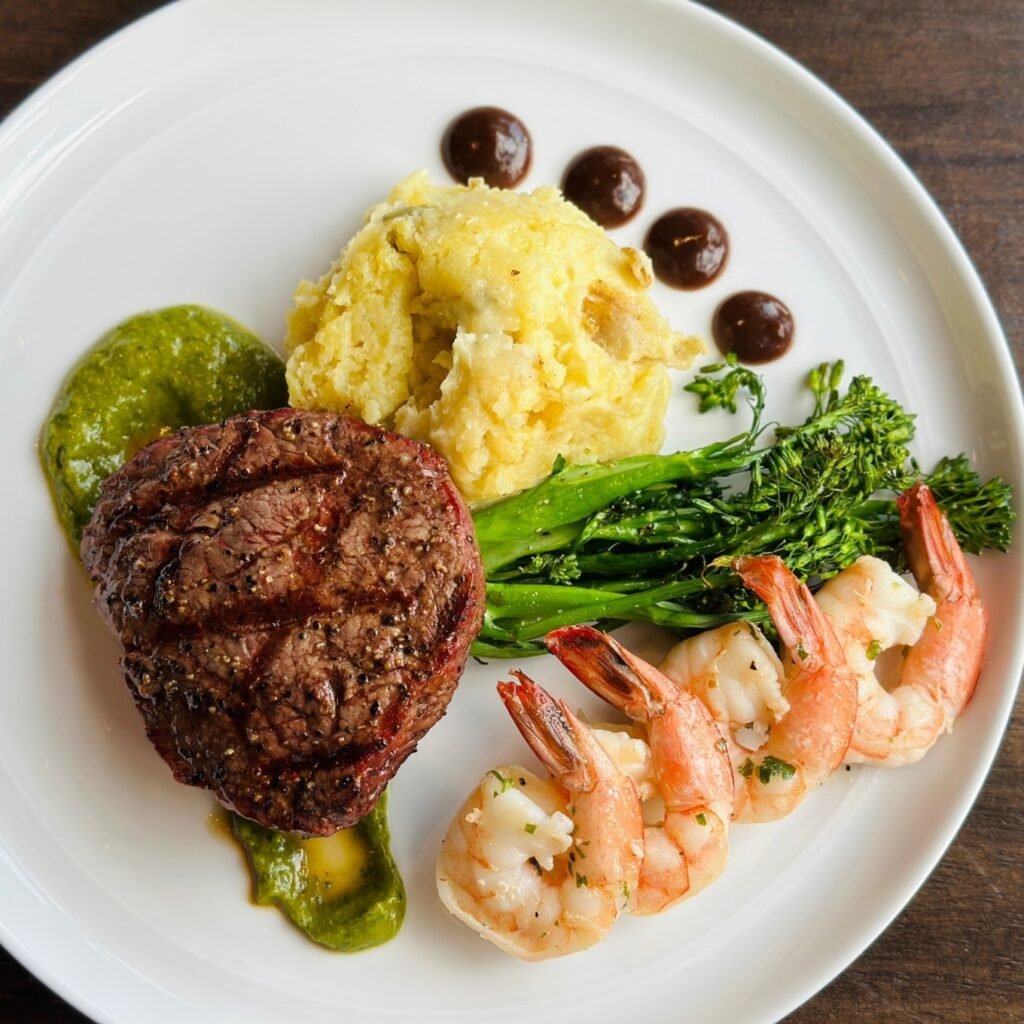
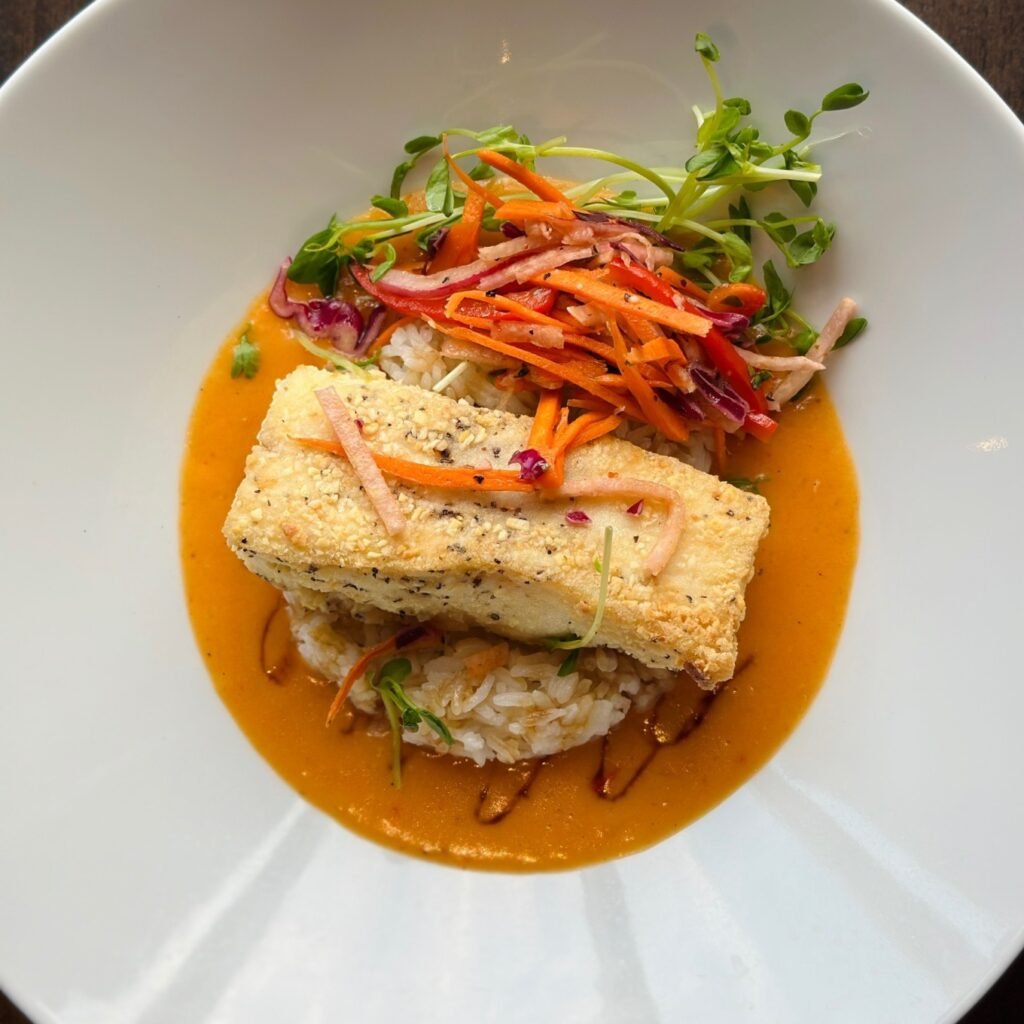
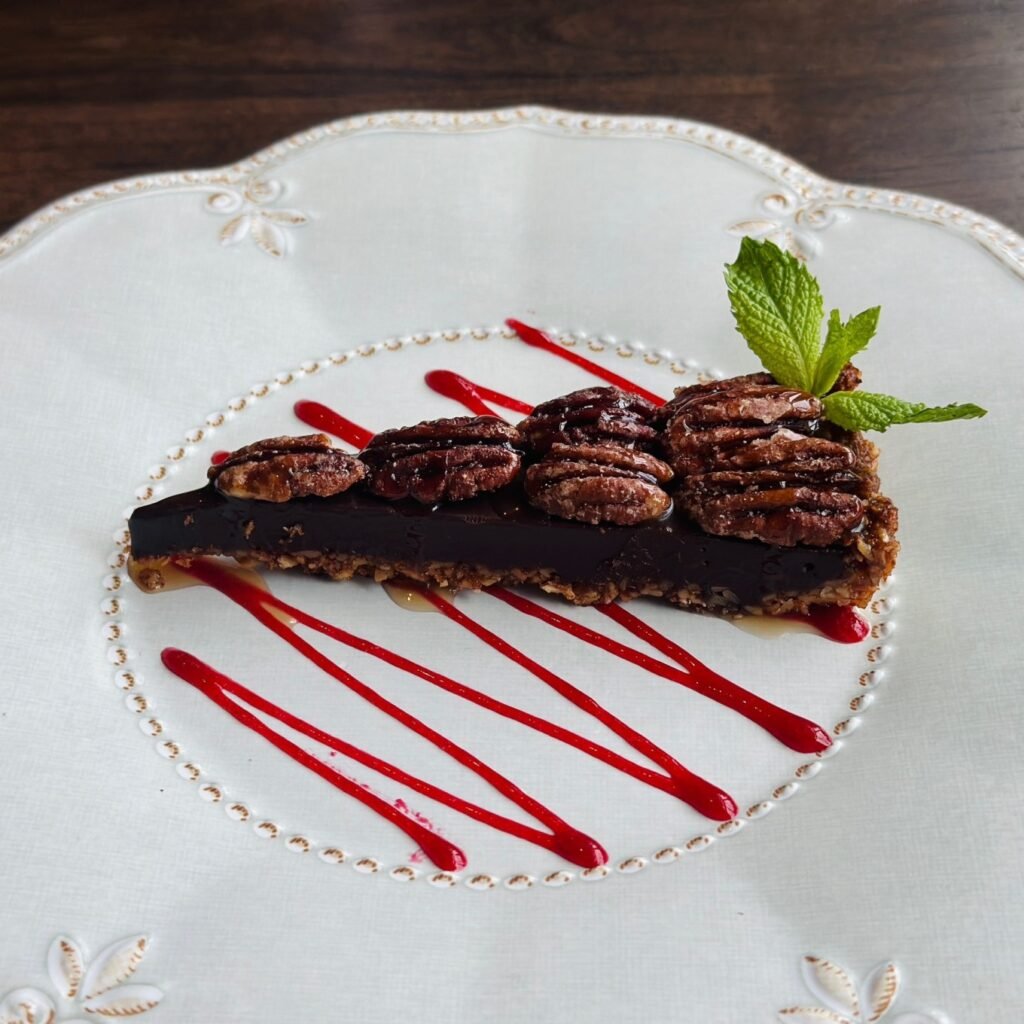
Maligne Canyon
Maligne Canyon is the longest, deepest, and most unique canyon in the entire Rocky Mountains. It’s a classic example of a karst landscape, forming a suspended canyon. Unlike most canyons, where you typically hike along streams at the bottom while gazing up at the towering cliffs, Maligne Canyon offers a different experience — we walked along the upper edge of the canyon, looking down at the lush, green valley below.
The river flowing through the canyon originates from Maligne Lake upstream. As it passes through, it carves a winding, narrow gorge into the limestone bedrock, stretching about 2 kilometers. The deepest part is said to reach 55 meters. There are six bridges in total, but if you start your visit from the 1st/2nd bridge parking area, hiking to the 4th bridge is enough to enjoy the best views.
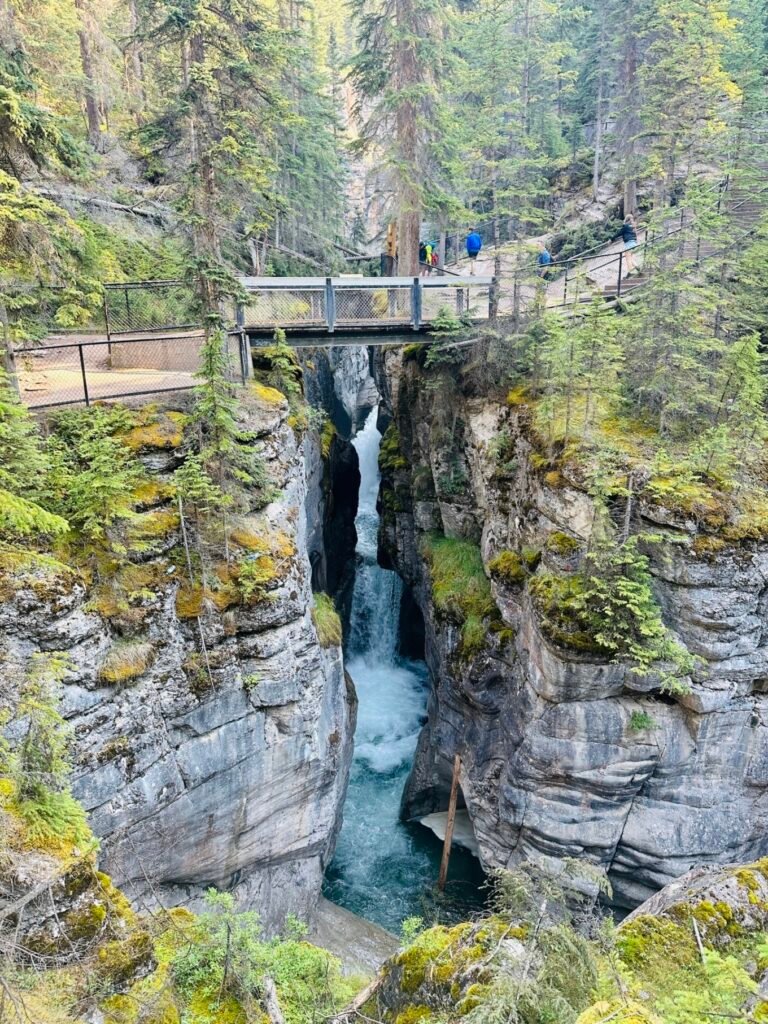
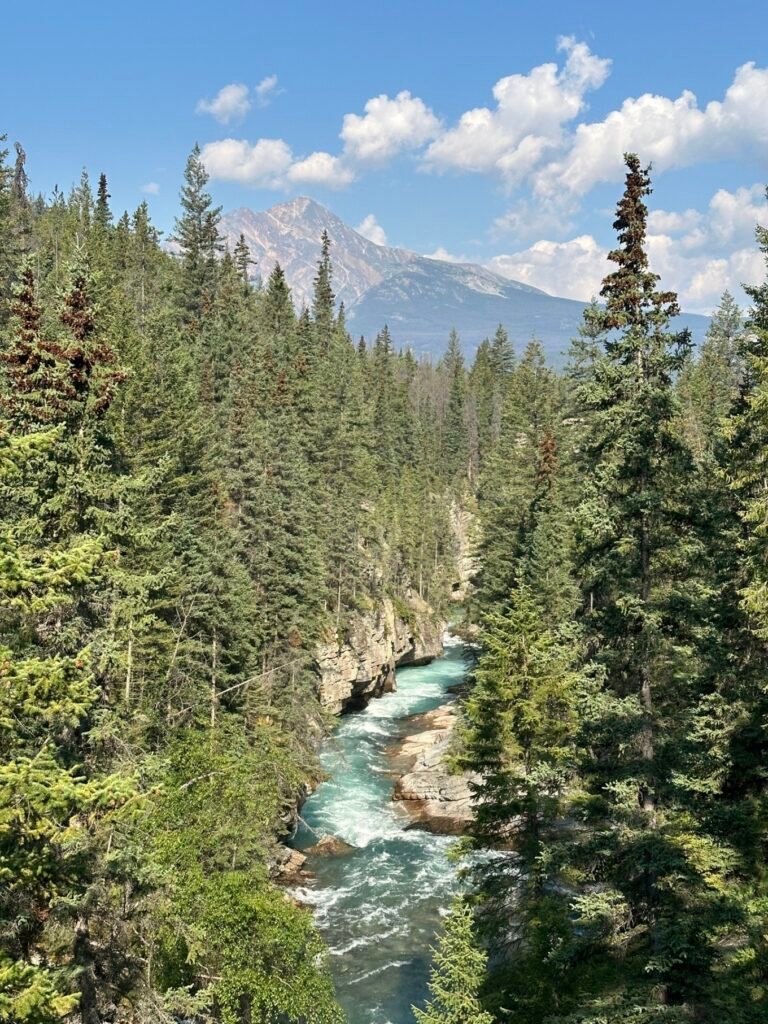
The visitor center has a great restaurant and gift shop, with Indian-style paintings decorating the space. They serve things like fries, fried chicken, and fish, all reasonably priced and quite tasty. If it’s not too crowded, I recommend sitting outside — the sound of the flowing stream adds to the relaxing atmosphere.
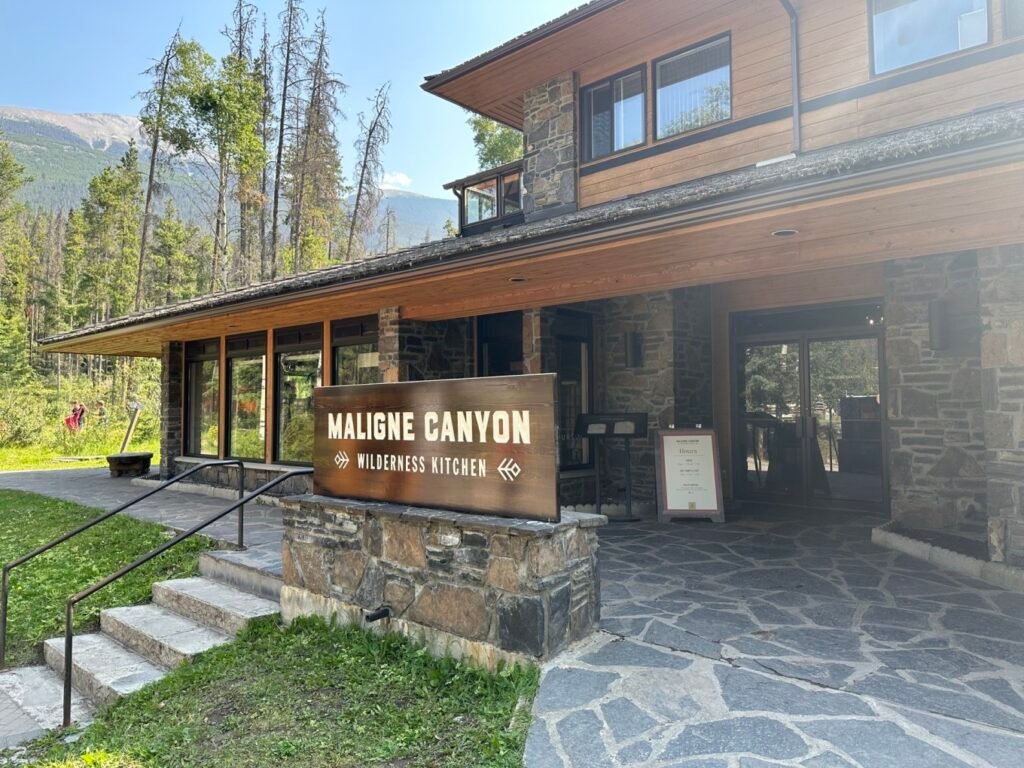
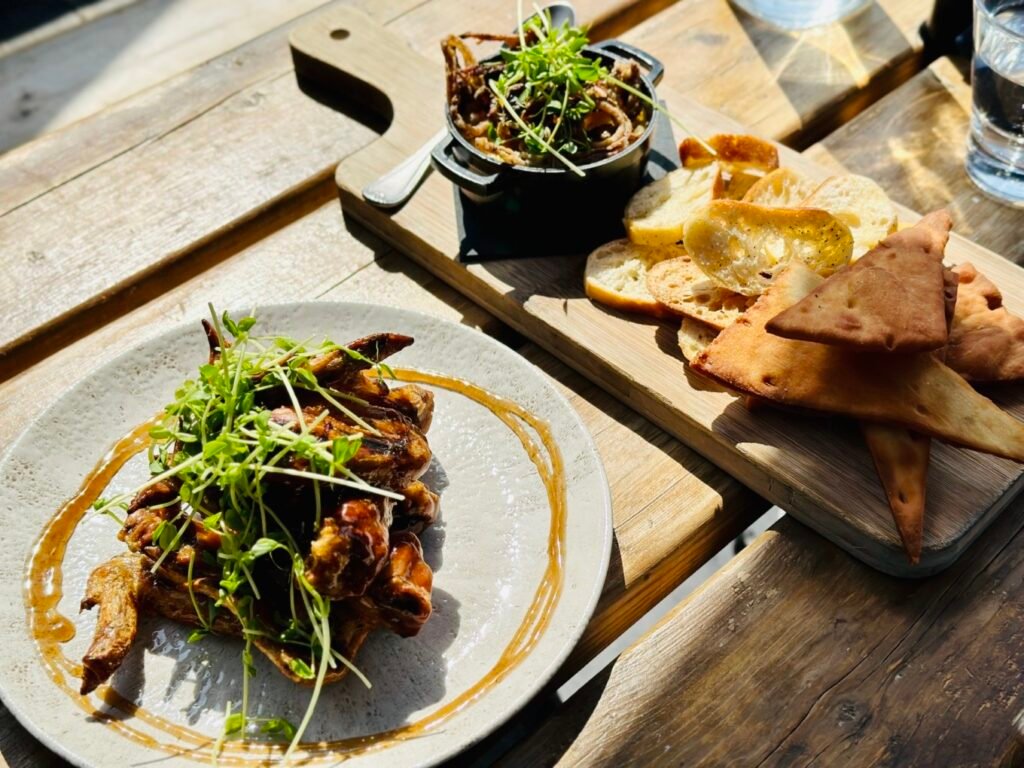
Medicine Lake
Medicine Lake is located along the road to Maligne Lake. Its unique name comes from a fascinating natural phenomenon — the lake’s water level remains normal during the spring and summer but gradually begins to disappear around October. Throughout the year, the water level can fluctuate by as much as 20 meters.
The local Indigenous people couldn’t explain this strange occurrence and believed it was caused by magical forces, hence the name “Medicine Lake.”
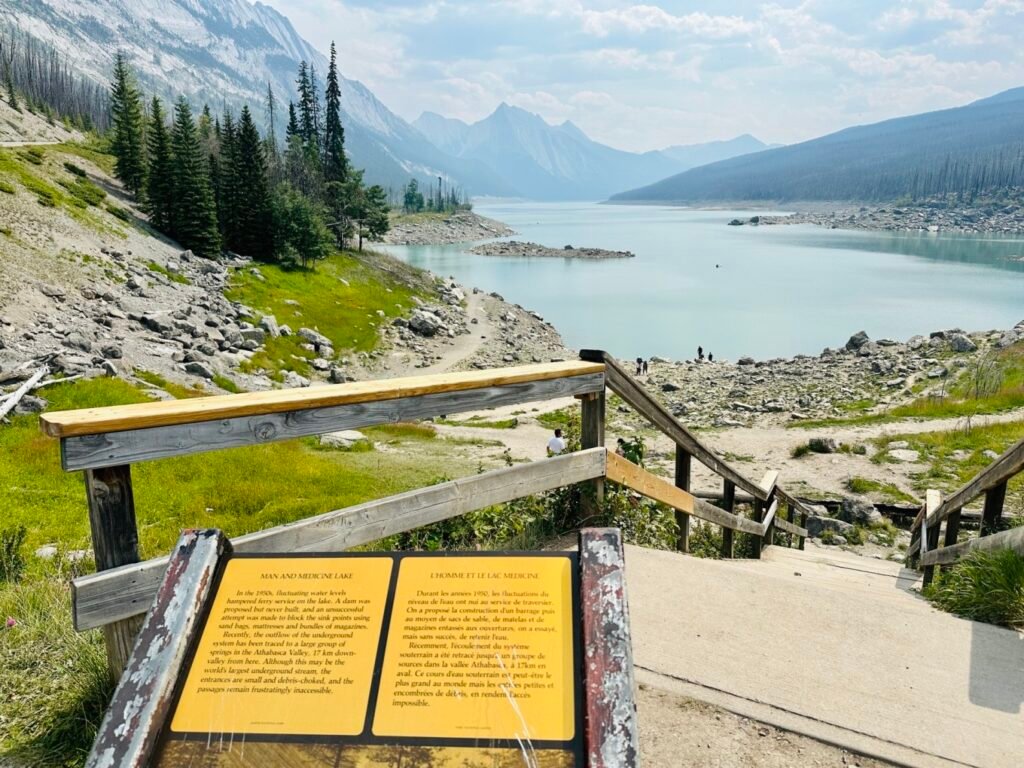
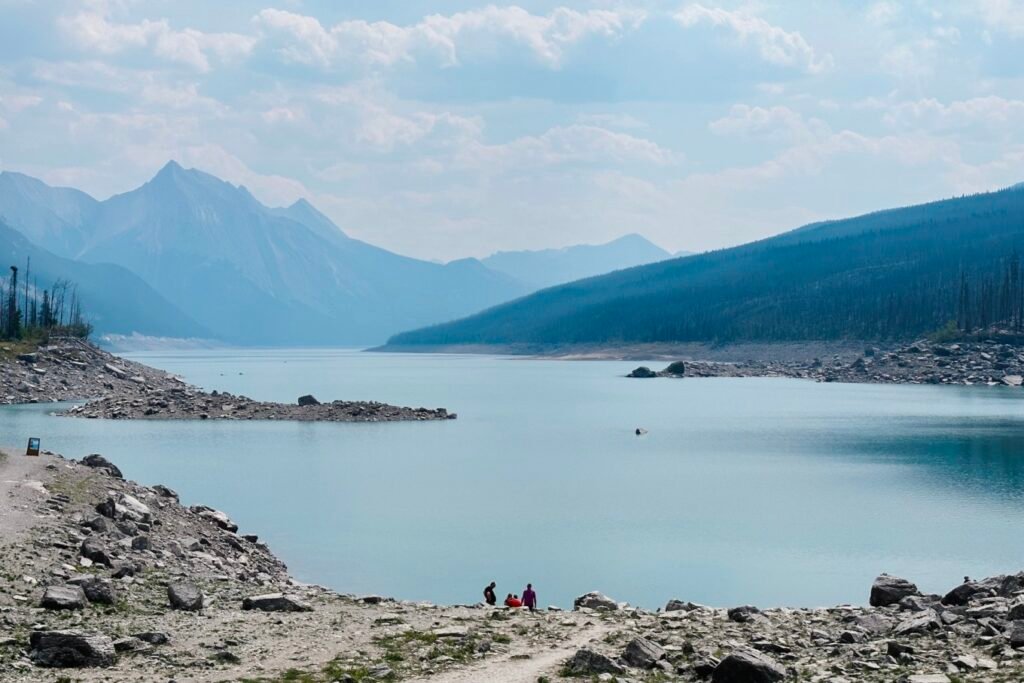
Maligne Lake & Spirit Island
Maligne Lake is the largest natural lake in Jasper National Park, stretching 22 kilometers with a maximum depth of 96 meters. The park offers boat tours, water activities, and several hiking trails around the lake. One of the most popular experiences is the boat cruise to the iconic Spirit Island.
The boat ride includes free commentary, and along the way, passengers may spot various wildlife. The journey culminates at Spirit Island, surrounded by stunning glacier-capped mountains. There’s a dock near the island where the boat stops, allowing visitors to disembark and walk a designated path to take photos of the picturesque island. The stop lasts about 15 minutes before heading back, with the entire trip taking around an hour and a half.
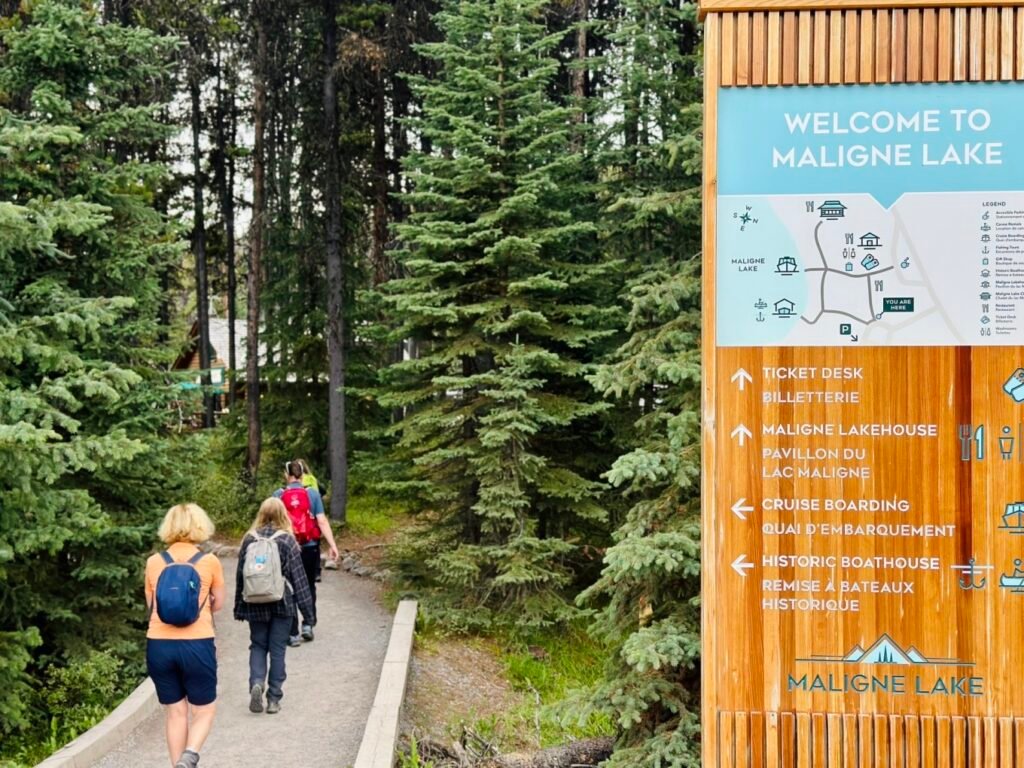
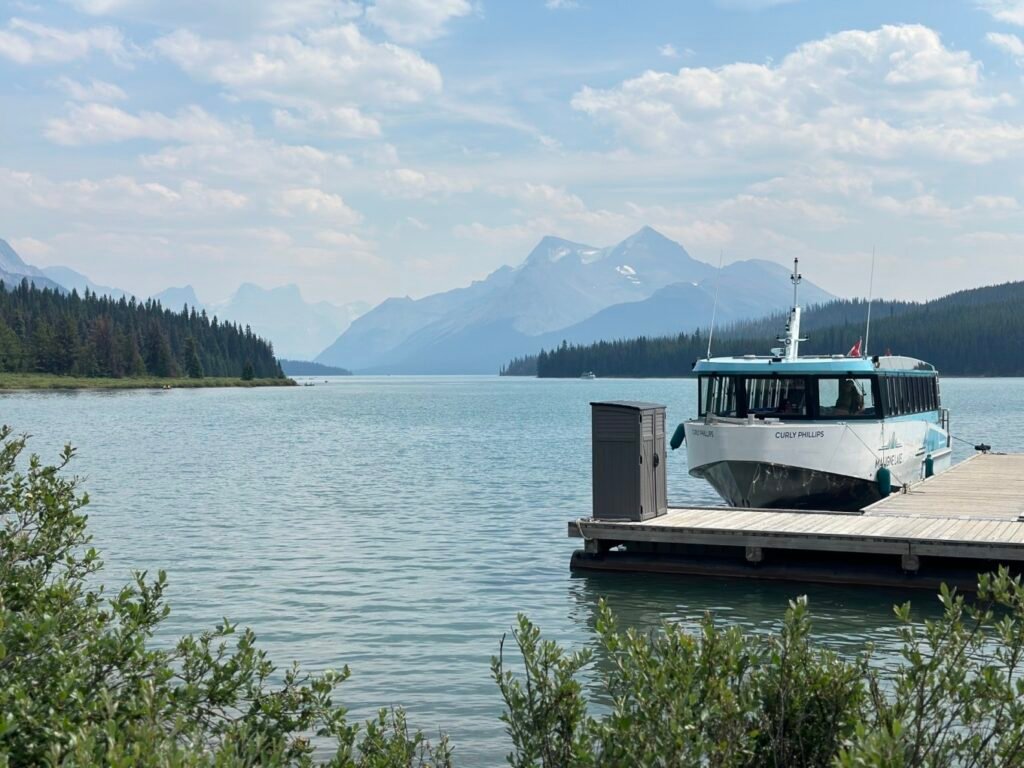
Syrahs of Jasper – Steakhouse
For dinner, we headed back to Jasper town. Syrahs is quite popular locally, known for offering unique meats like venison and bison. Since we’re not big fans of game meat, we stuck to what we enjoy — a classic steak and a duck breast meal. Of course, no meal is complete without dessert! The Goat Cheesecake was rich and flavorful, definitely worth trying. All in all, we highly recommend it.
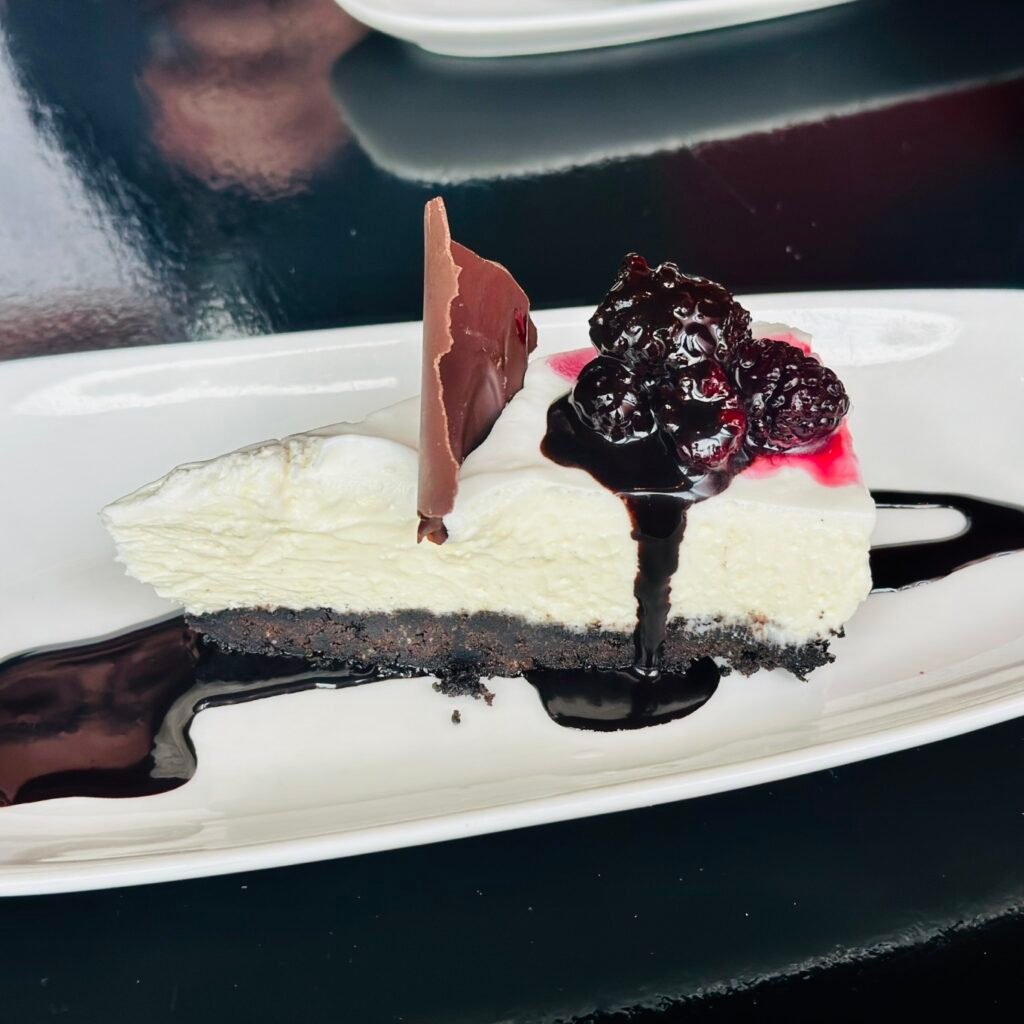
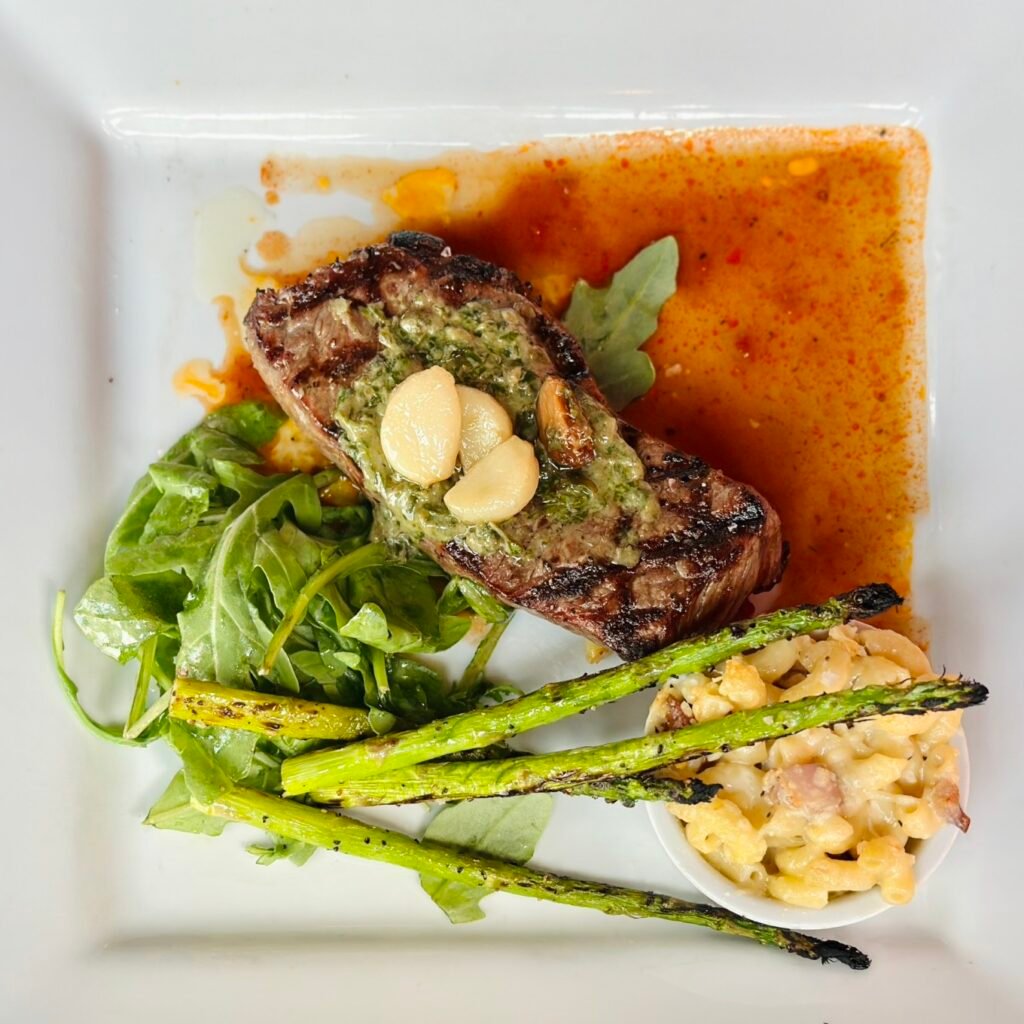
Angel Glacier
While planning the trip, we read some great reviews about Angel Glacier, so we decided to include it in our itinerary. From the resort, we took a detour onto Highway 93A, also known as the Old Highway. The route was easy to follow, though it involved a lot of winding mountain roads with several near 180-degree turns. Driving slowly made it manageable.
Our first stop was Cavell Lake, and from there, we continued to the parking lot. The trail to Angel Glacier is also the first section of the Cavell Meadows hiking route. After a 10-minute walk, we reached the viewpoint, where we could see the glacier, the glacial meltwater lake, and Mount Edith Cavell in the distance.
A side trail of loose gravel leads all the way down to the edge of the glacial lake. This is a lesser-known, uncrowded spot, offering a close-up experience of the glacier’s awe-inspiring presence.
However, if the weather is bad or the glacier seems unstable, it’s best not to venture down to the lake since it could be dangerous. Just as we were about to leave, we heard a loud cracking sound from the mountain — the glacier melting. It wasn’t a massive collapse, but it was still surprising to hear, especially since it was already August, and we assumed most of the ice that could melt would have melted by now.
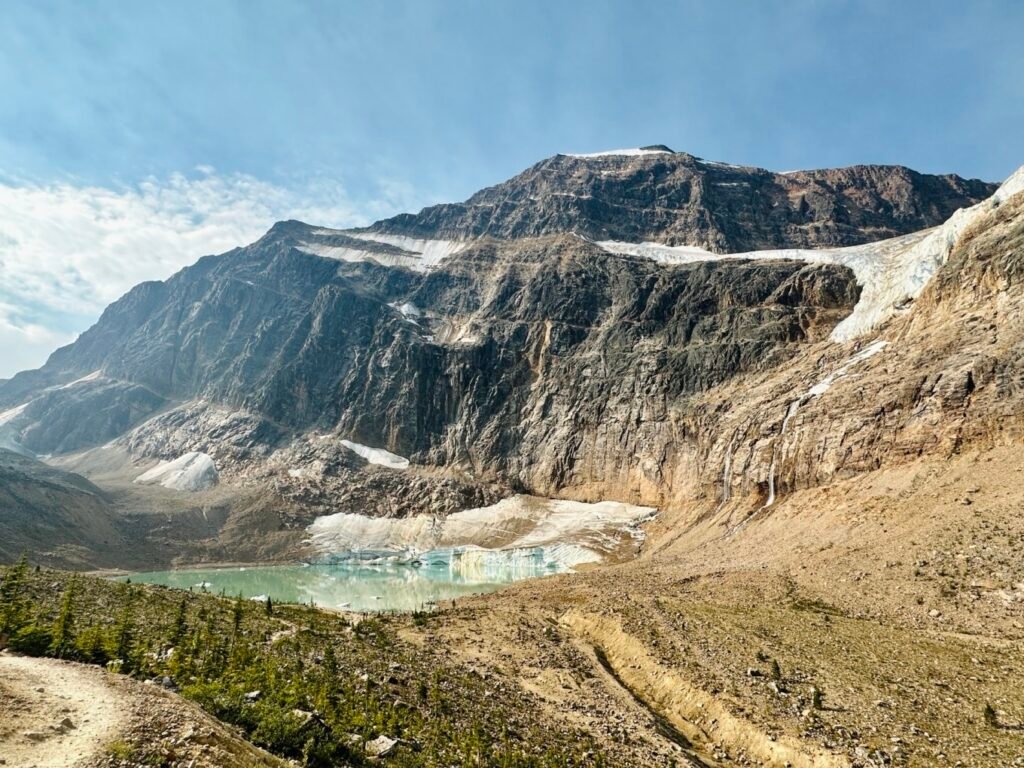
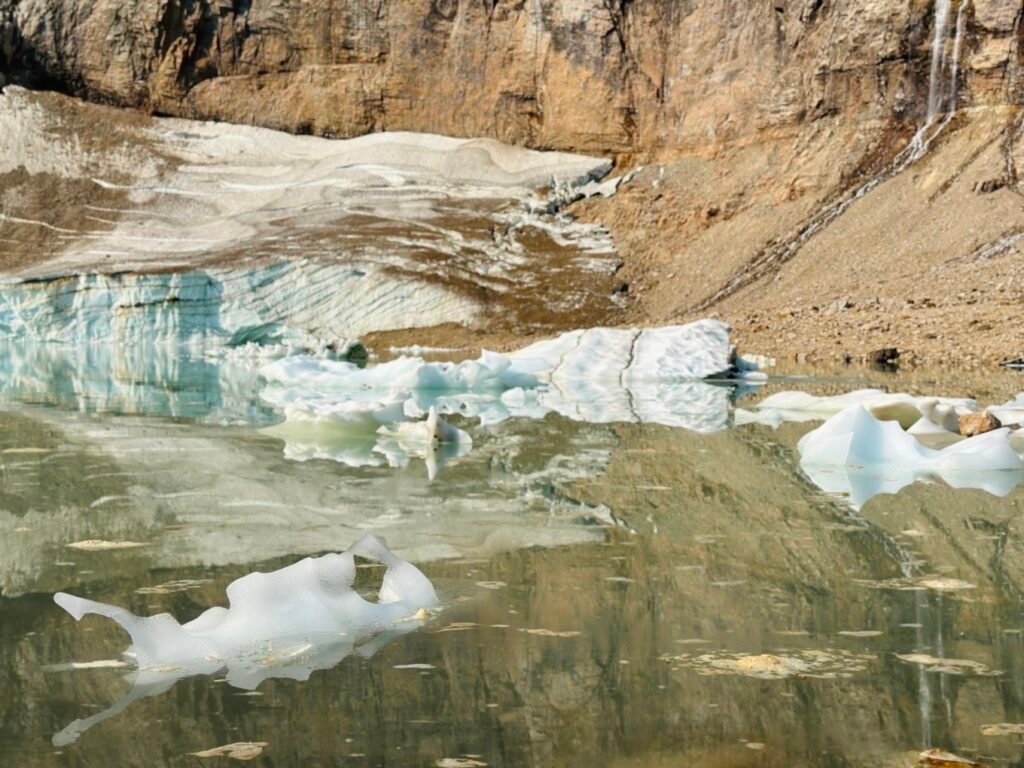
Athabasca Falls is one of the most famous waterfalls in Jasper National Park. Although it’s only a little over 20 meters tall, the sheer volume of water rushing through it is immense, creating a thunderous roar that’s truly awe-inspiring. Over the years, the powerful water flow has carved the canyon it passes through, forming striking vertical cliffs that make the scenery even more unique.
The waterfall isn’t very large, but it’s definitely worth a visit. It’s only a few minutes’ walk from the parking lot, making it an easy stop. Athabasca Falls is also a great place to take a break on the way to the Columbia Icefield.
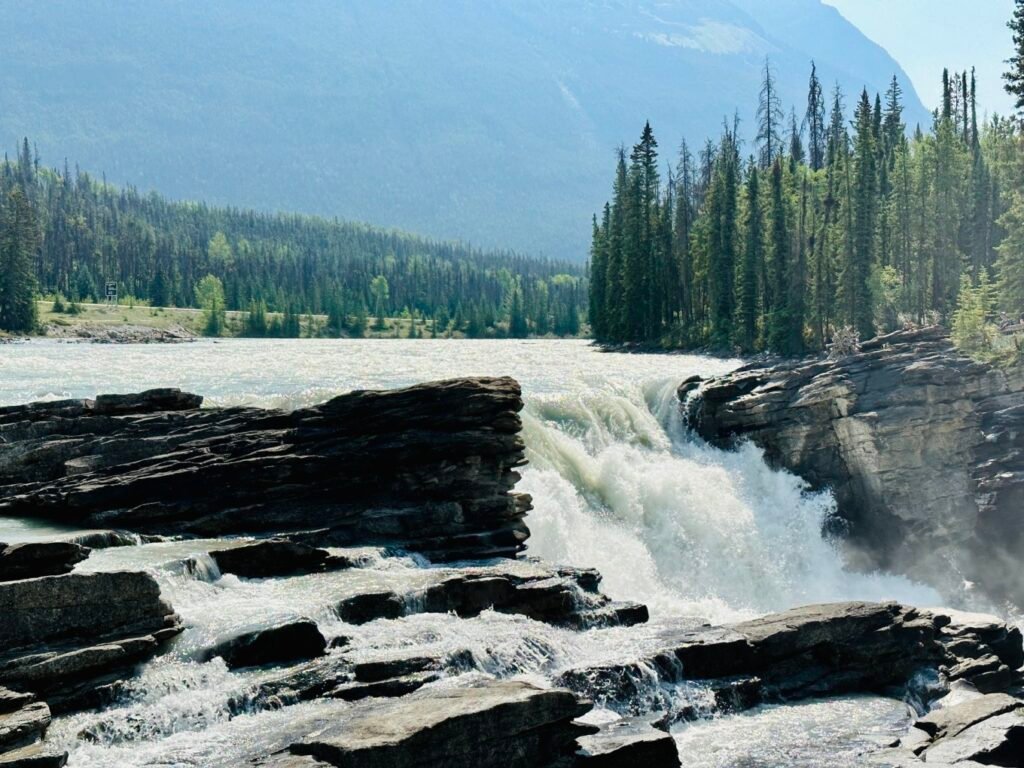
Icefields Parkway
The Icefields Parkway, also known as Highway 93, is the must-travel route from Athabasca Falls to the Columbia Icefield. It truly lives up to its reputation as one of the most beautiful roads in the world — it left a lasting impression on me!
The parkway winds through Jasper National Park, starting in Jasper Town and ending at Lake Louise. Along the way, the breathtaking scenery of the Rocky Mountains unfolds like a painting. You’ll pass through dense forests, serene lakes, wetlands, waterfalls, vast icefields, and snowy peaks, with every stretch of road offering new wonders to admire.
The road is well-maintained, with two lanes (one in each direction) and occasional passing lanes. The speed limit is 90 km/h, and most of the route is fairly straight, though there are more curves near the Columbia Icefield. It’s a journey filled with spectacular views that makes every mile worth it.
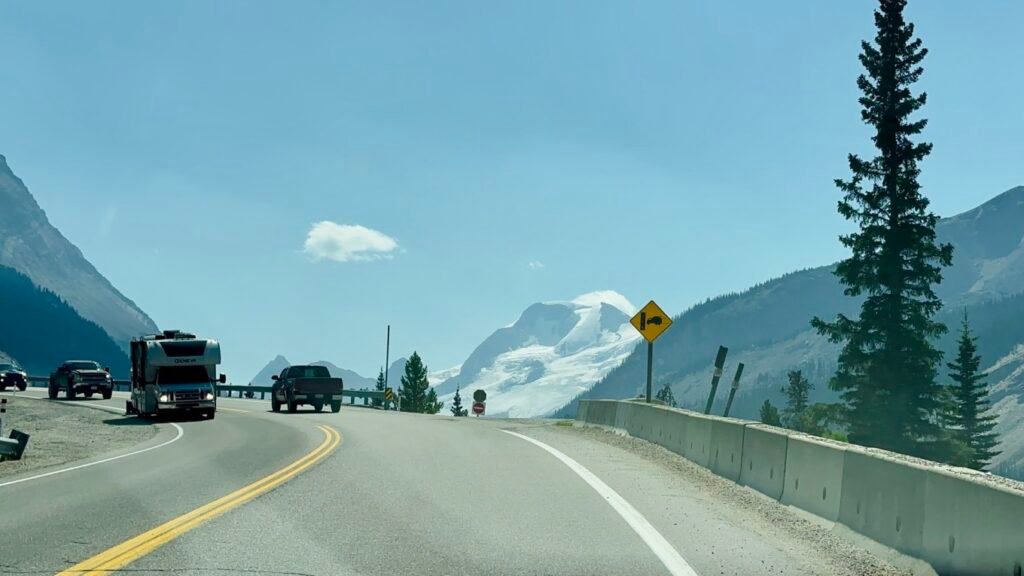
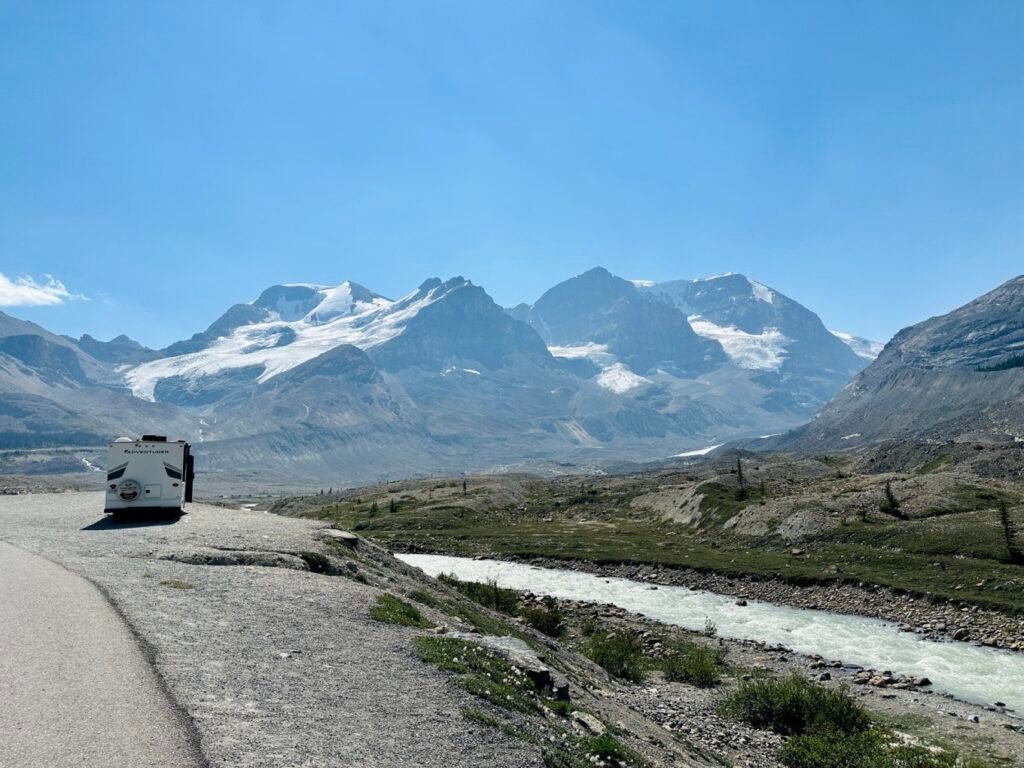
Columbia Icefield
The Columbia Icefield is the largest icefield in the Rocky Mountains, covering an area of 365 square kilometers. It’s one of the largest remnants of an icefield outside the Arctic Circle.
To visit the icefield, you’ll need to purchase tickets at the visitor center (ours was included in a combo ticket we bought online, with a time slot booked for 3:30 PM). Private vehicles aren’t allowed on the icefield, so visitors first board a shuttle bus that takes them to the base station, where they transfer to massive Ice Explorer vehicles. The ride up the glacier is thrilling, with steep slopes adding an extra dose of excitement to the experience.
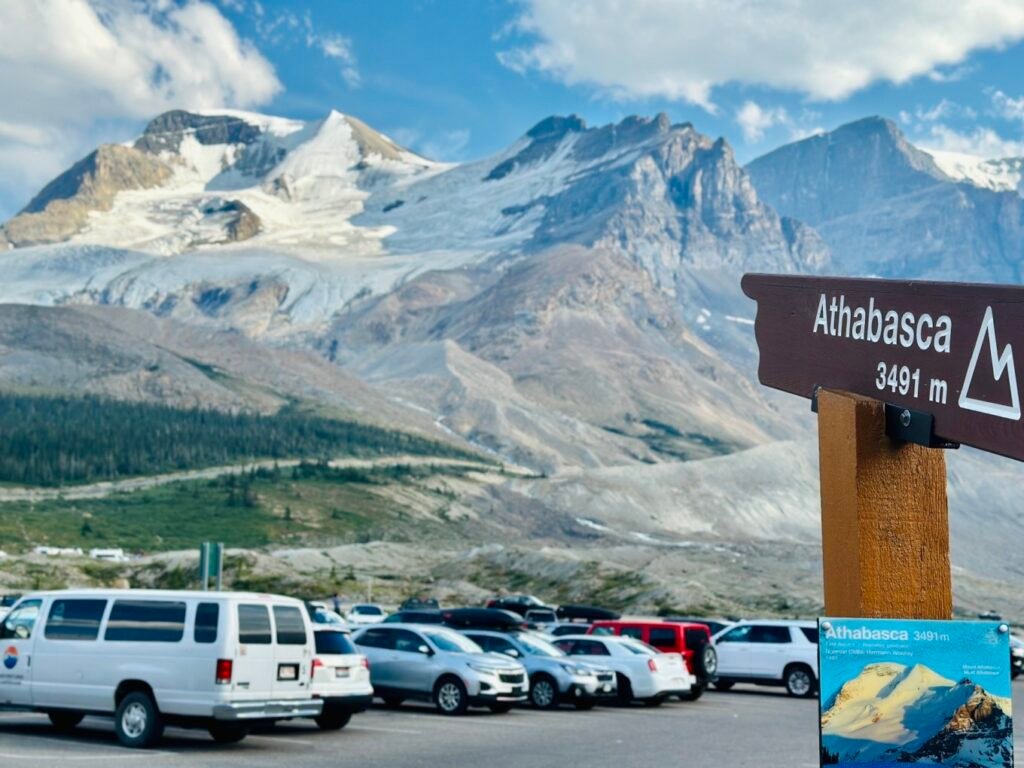
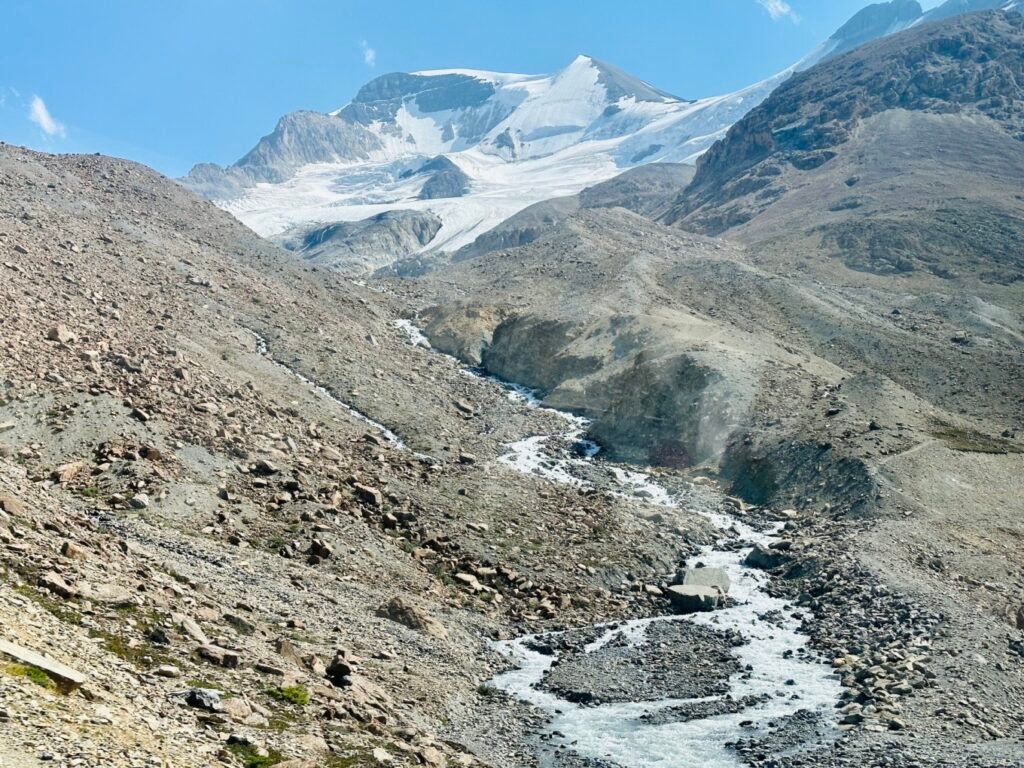
Once on the icefield, visitors are free to explore within a designated area. The scenery is breathtaking — this is a real icefield with pristine glacial water that you can drink straight from the source. In my opinion, it’s the one destination along the Rockies that you absolutely can’t miss.
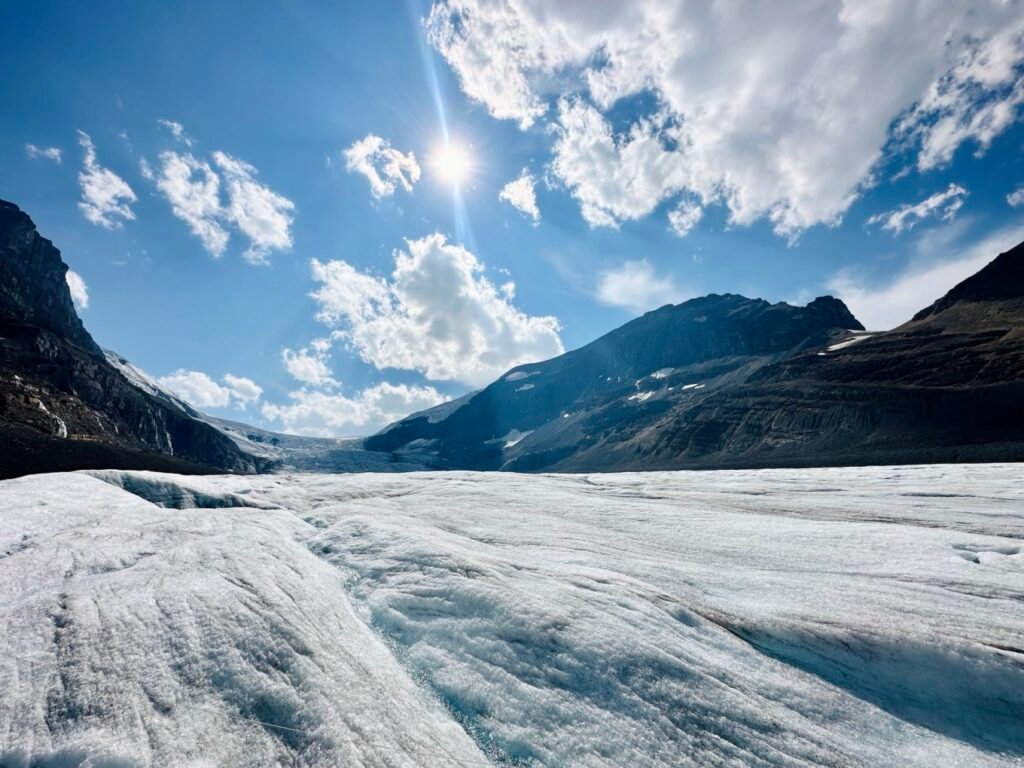
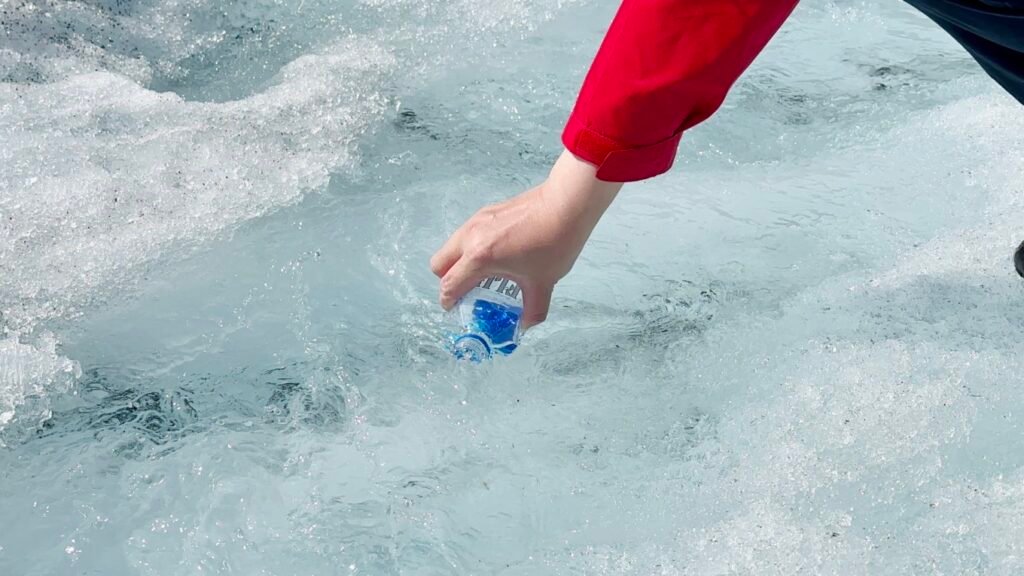
Glacier Skywalk
The Glacier Skywalk is located along the Icefields Parkway, just minutes from the Columbia Icefield and the Glacier Discovery Centre. This attraction allows visitors to walk along an open cliffside path leading to a glass-floored observation platform, suspended 280 meters above the Sunwapta Valley.
This spectacular site is considered one of the most unique ecosystems in the world. It’s not only an incredible spot for breathtaking views but also an excellent place to learn about ecology, geology, glaciology, and the natural history of the Columbia Icefield region.
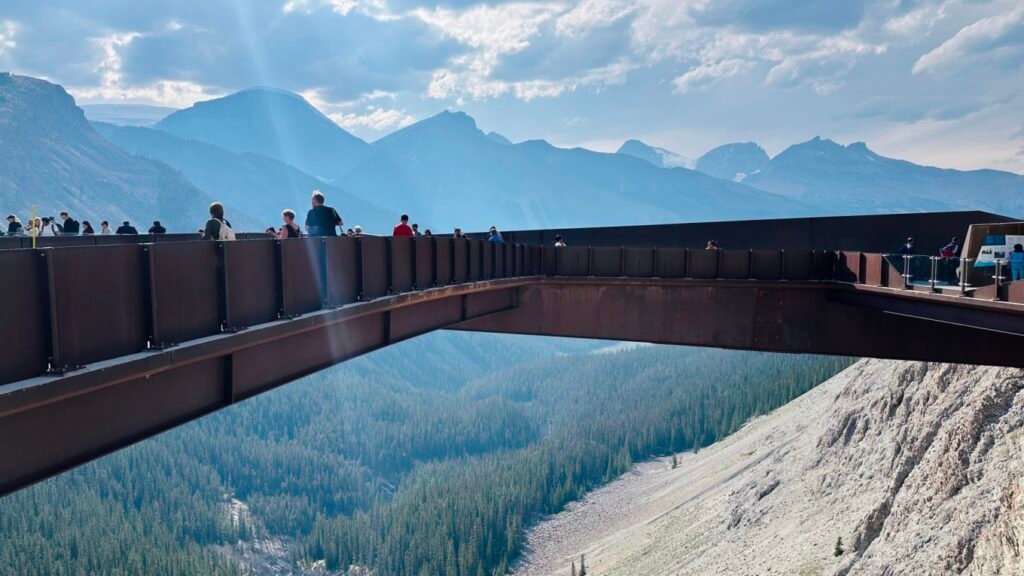
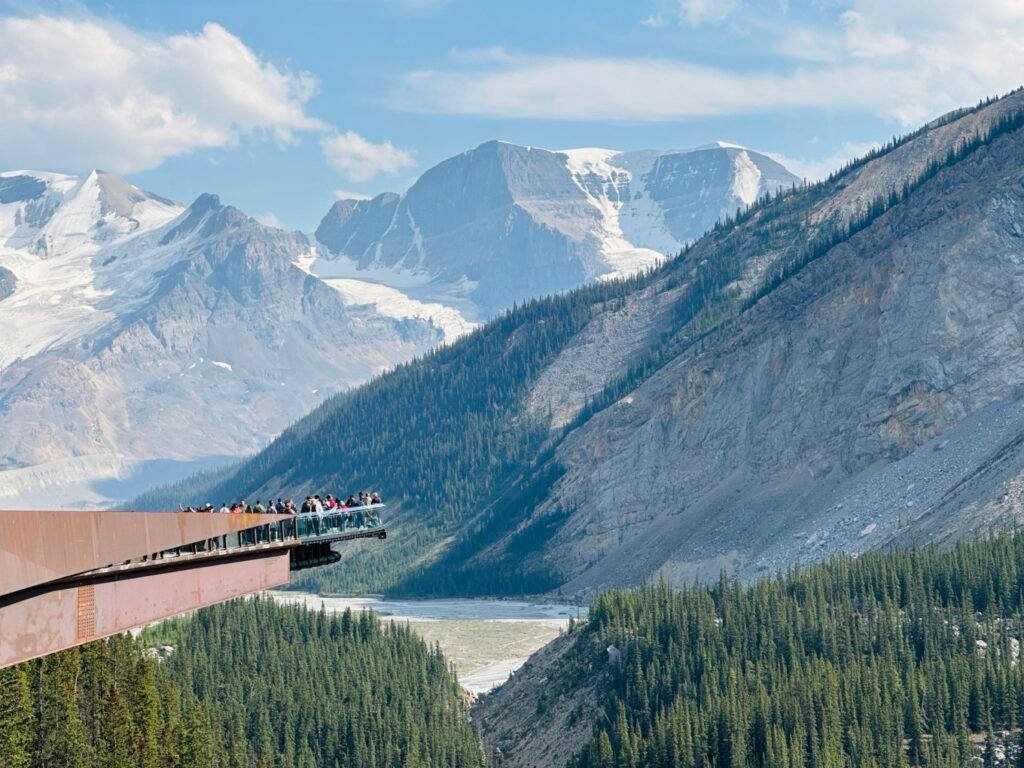
Peyto Lake
There are no signs along the Icefields Parkway pointing to Peyto Lake, so to see the full view, we entered “Bow Summit” into Google Maps. We parked at the designated lot and walked about 10 minutes up a slope to reach the Peyto Lake viewpoint.
The moment we stepped onto the viewing platform, the scenery opened up before us — the entire lake lay in view, shaped like a distorted maple leaf. The water was calm and serene, radiating a sense of tranquility. Although the air was still hazy from wildfire smoke, it didn’t diminish Peyto Lake’s status in our minds as the most beautiful lake we’ve seen.
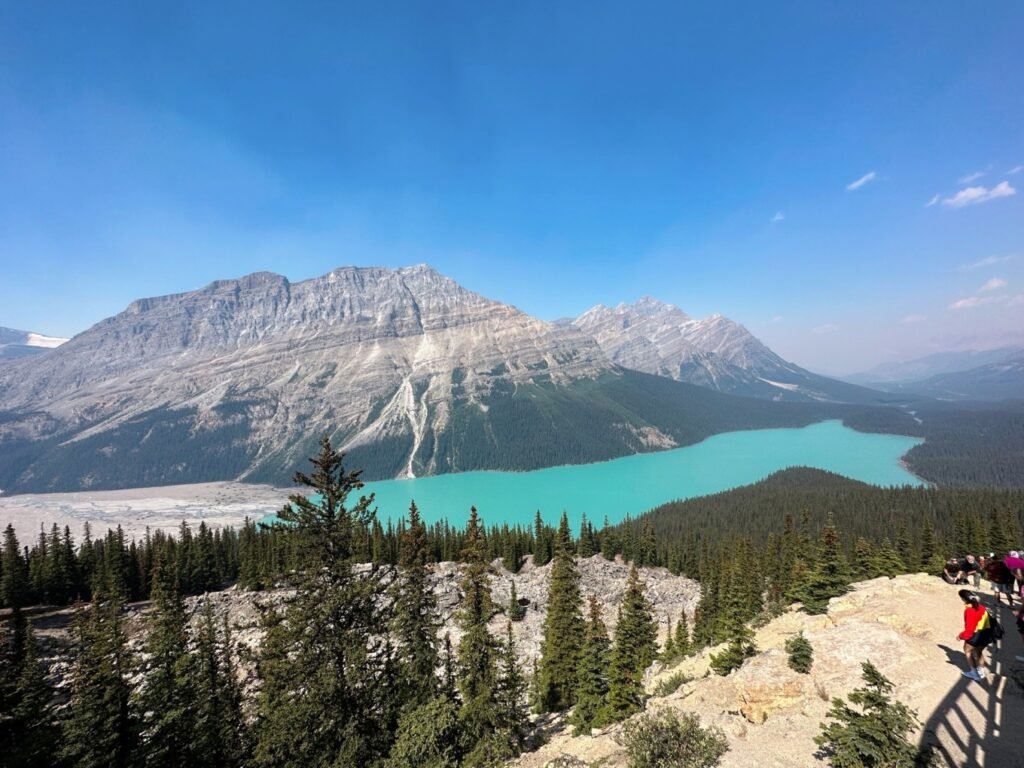
Bow Lake
Bow Lake sits right along the Icefields Parkway. Although it’s not as famous as some of the other lakes, its beauty is no less impressive. Like many lakes in the Rockies, it’s fed by meltwater from mountain snow, and the minerals and vegetation carried along the way give the water its stunning shades of blue and green.
A short trail leads to the water’s edge, where the crystal-clear lake, framed by the majestic Bow Glacier in the background, creates a magical atmosphere. There’s a sense of romance in this meeting of mountains and water, making it hard for us to tear ourselves away.
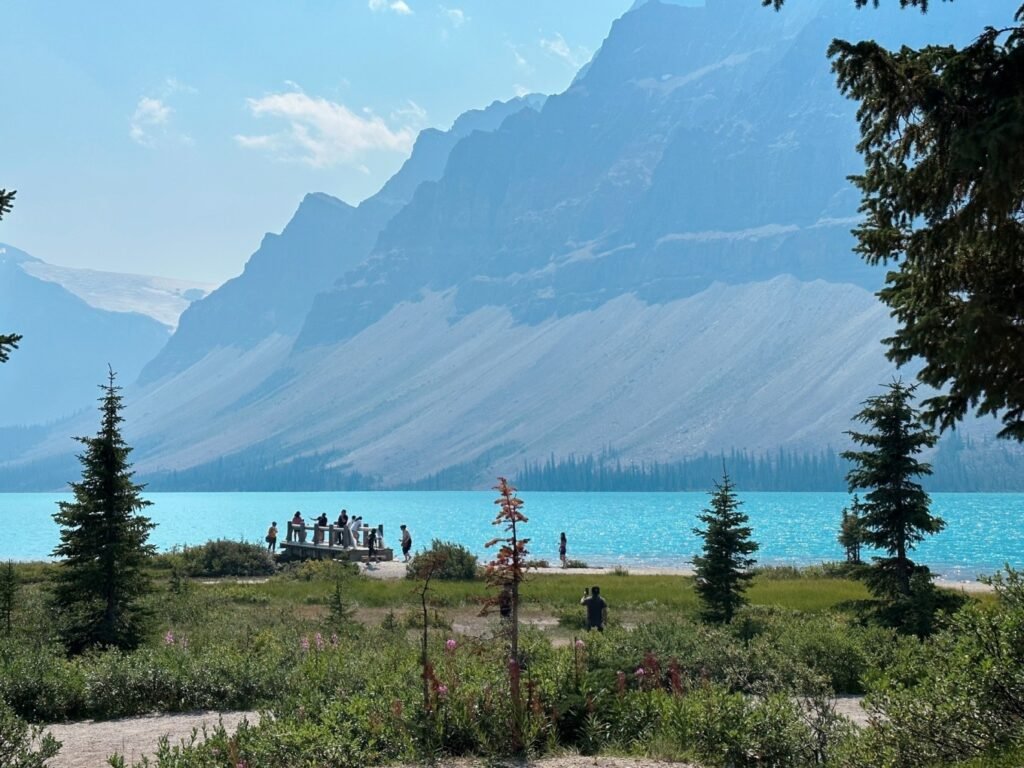
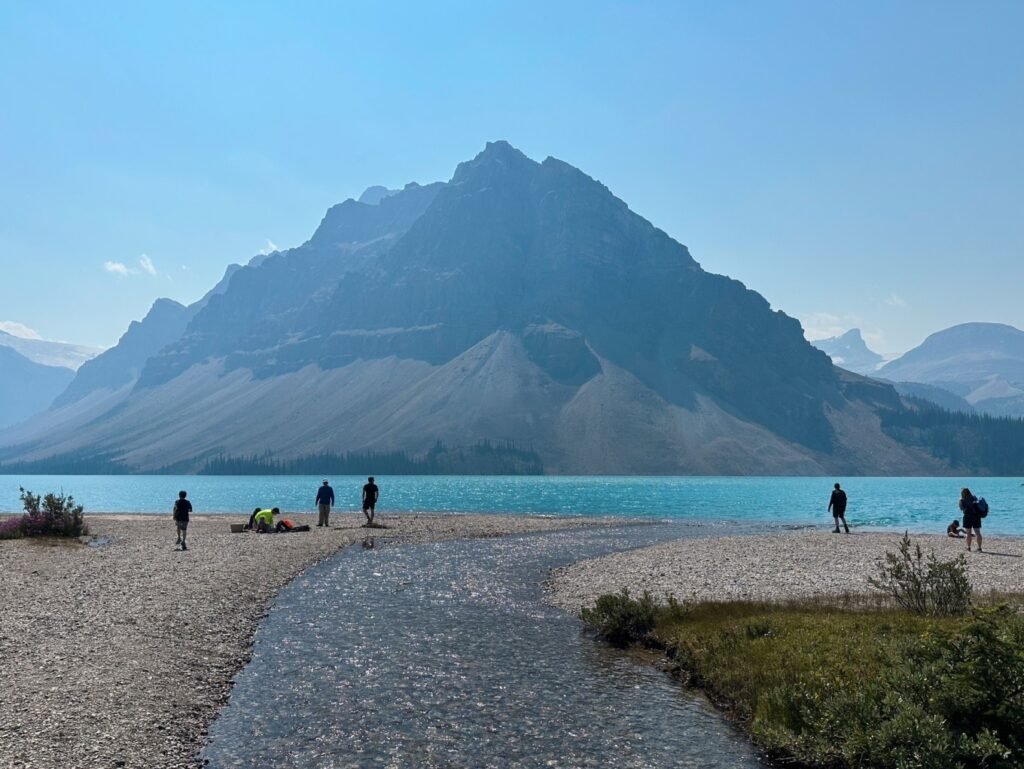
Fairmont Chateau Lake Louise 🏰
The hotel enjoys a prime location right next to Lake Louise, preserving the 18th-century Victorian architectural style. Its castle-like exterior blends harmoniously with the surrounding landscape of mountains and water. From the parking lot, there’s a dedicated elevator to the lobby, making access easy. Check-in was smooth, with friendly service throughout. The rooms are compact but elegantly furnished in a European style, clean and well-maintained.
After settling in, we headed to the front desk to inquire about the special discounts on boat rentals for hotel guests and details about the shuttle to Moraine Lake the next day. With our plans confirmed, we kicked off a leisurely three-day, two-night adventure around Lake Louise, exploring at our own pace.
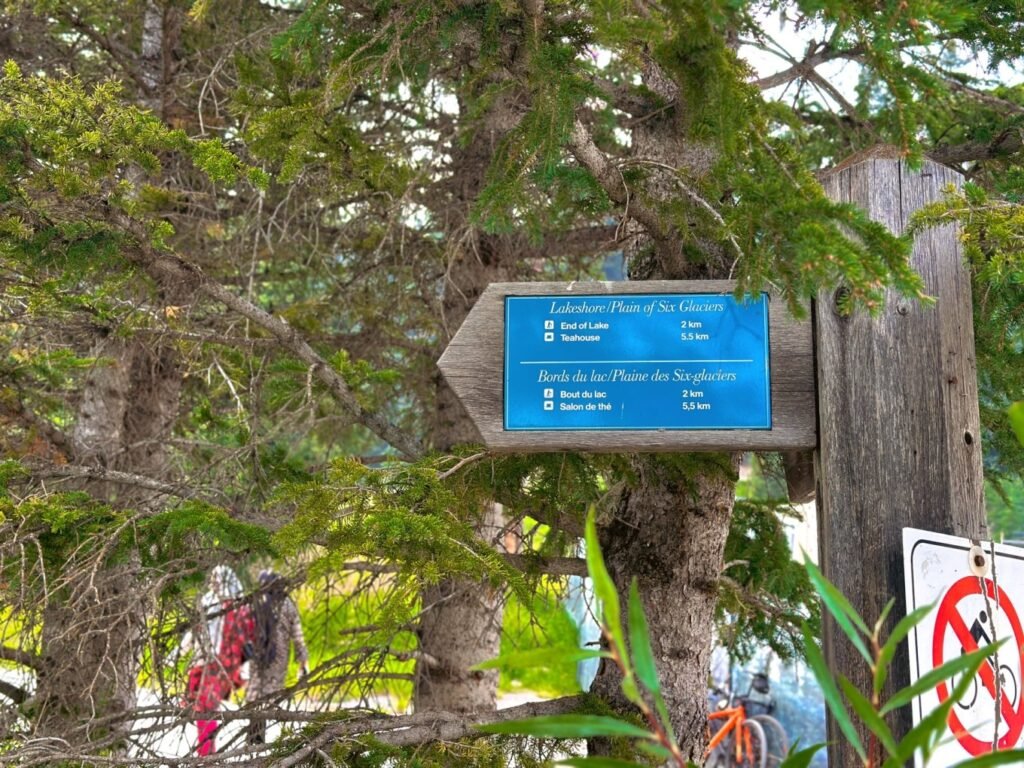
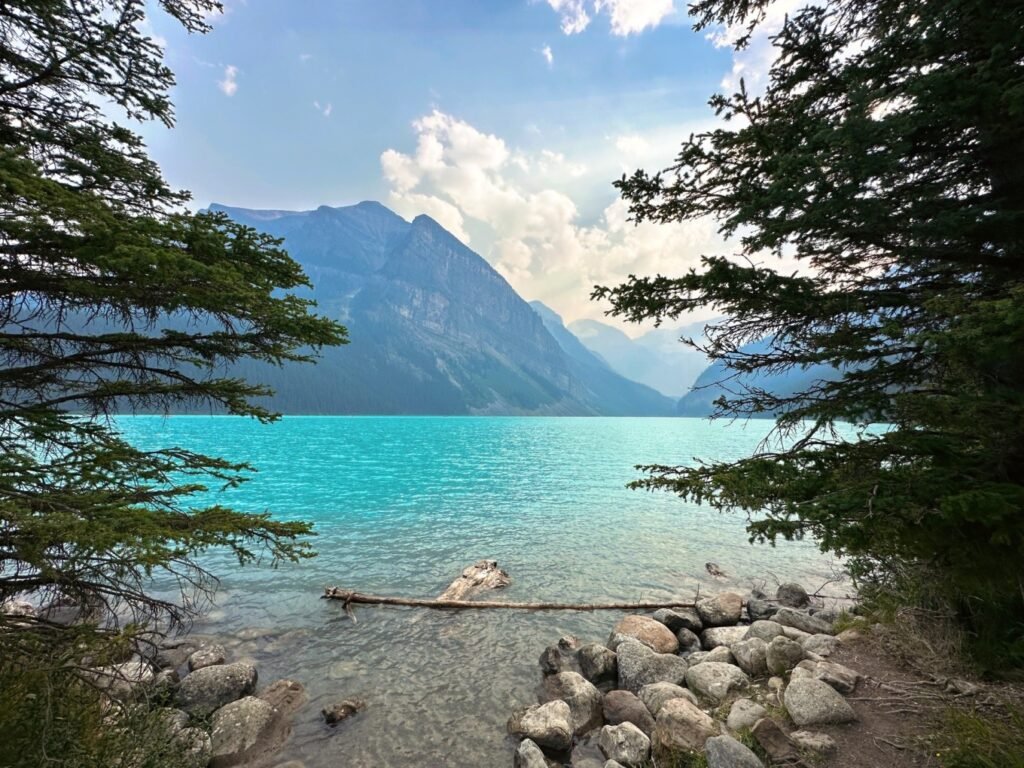
Moraine Lake – Watching the Sunrise Alpenglow
Moraine Lake is one of the most popular attractions in Banff, and the best way to experience it is to arrive early to see the alpenglow reflecting off the Ten Peaks. Since private vehicles have been banned from entering the area starting in 2023, the only way to get there is by shuttle bus.
Before dawn, we boarded the hotel’s shuttle bus to Moraine Lake, eager to witness the magical moment when the first light of sunrise casts a golden glow on the towering peaks, mirrored perfectly in the lake’s tranquil waters.
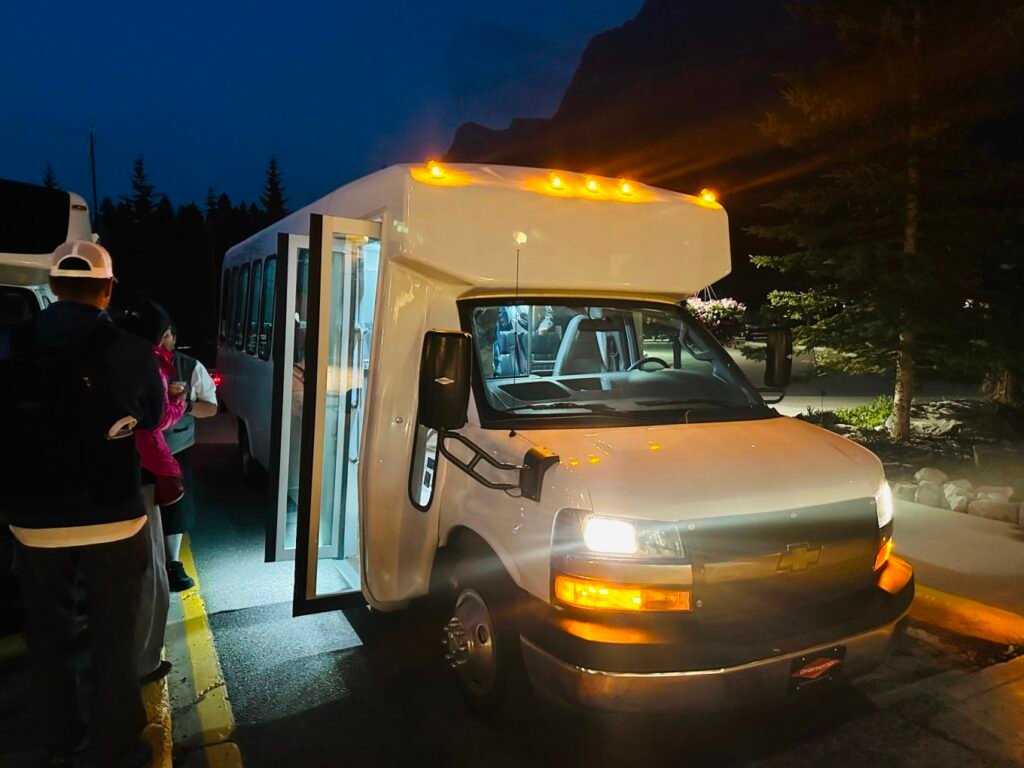
Having seen so many photos online, my expectations were already sky-high. But witnessing Moraine Lake in person, with its tranquil beauty, was beyond words. In that moment, all you could hear were collective “wows” and the clicks of camera shutters.
The rocky trail near the parking lot offers the best views of the lake. Once you’re up there, find a spot among the boulders. If you’re feeling adventurous, you can climb down for an even broader view.
Pro tip: Make sure to catch the sunrise! The lake isn’t nearly as stunning when the midday sun is shining directly on it. Though the wildfires somewhat dulled the brilliance of the alpenglow, the experience remained unforgettable, leaving a lasting impression on us.
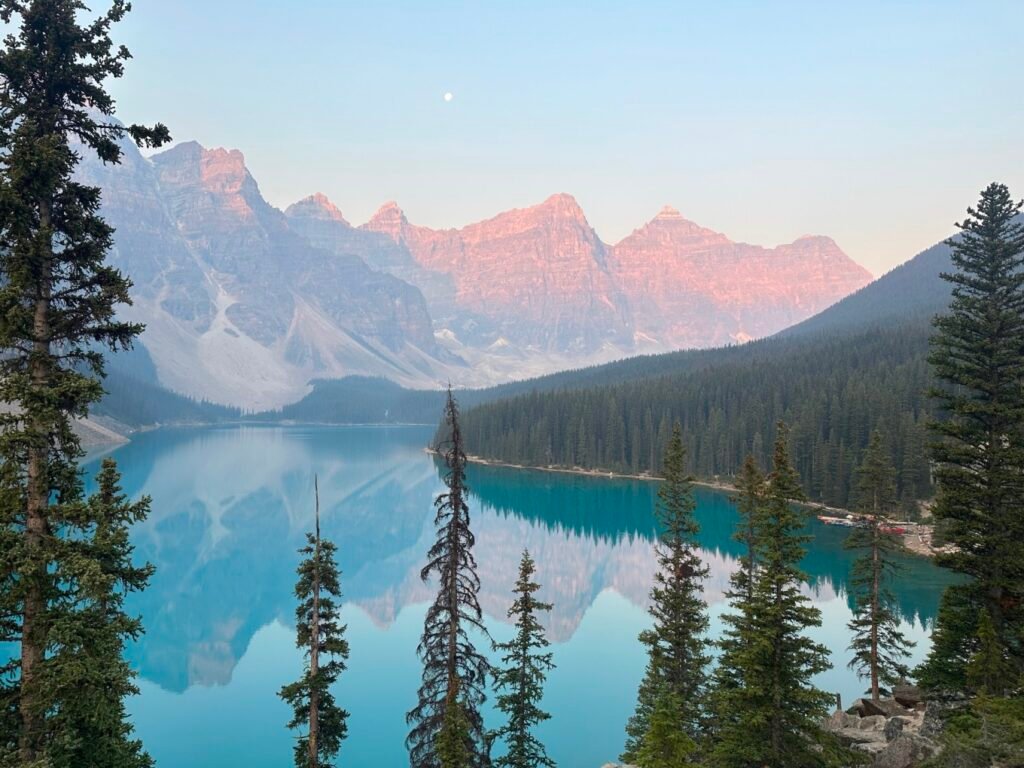

Lake Louise – Canoeing on the Water 🚣♀️
One of the must-do activities in Banff is canoeing on Lake Louise. For visitors, the rental fee is CAD 135, but hotel guests get a discounted rate of CAD 95. There’s also a dedicated access lane for guests, so there’s almost no waiting in line.
While waiting, the staff will have you fill out a form with your personal information. Before boarding, they provide life jackets and make sure everyone puts them on properly. Each person also receives a small whistle to use in case of an emergency.
Typically, it’s two people per canoe, with each person using one paddle (though the canoes can accommodate up to three people). The preparation is smooth and well-organized, ensuring a safe and enjoyable experience on the water.
Seeing Lake Louise from the canoe offers a whole new experience. As you paddle across the water, the snow-capped mountains ahead seem to draw closer, while the noise of the crowd onshore fades away. The serene blue-green waters are so close that you can reach out and touch them. It truly feels like being transported to a magical paradise.
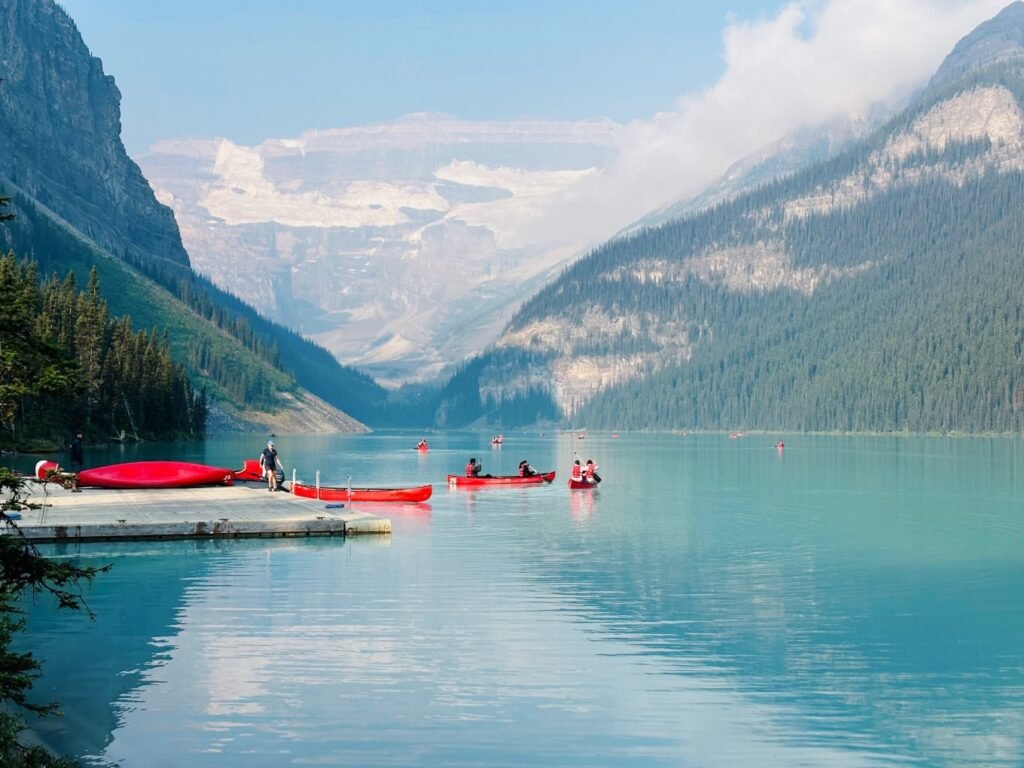
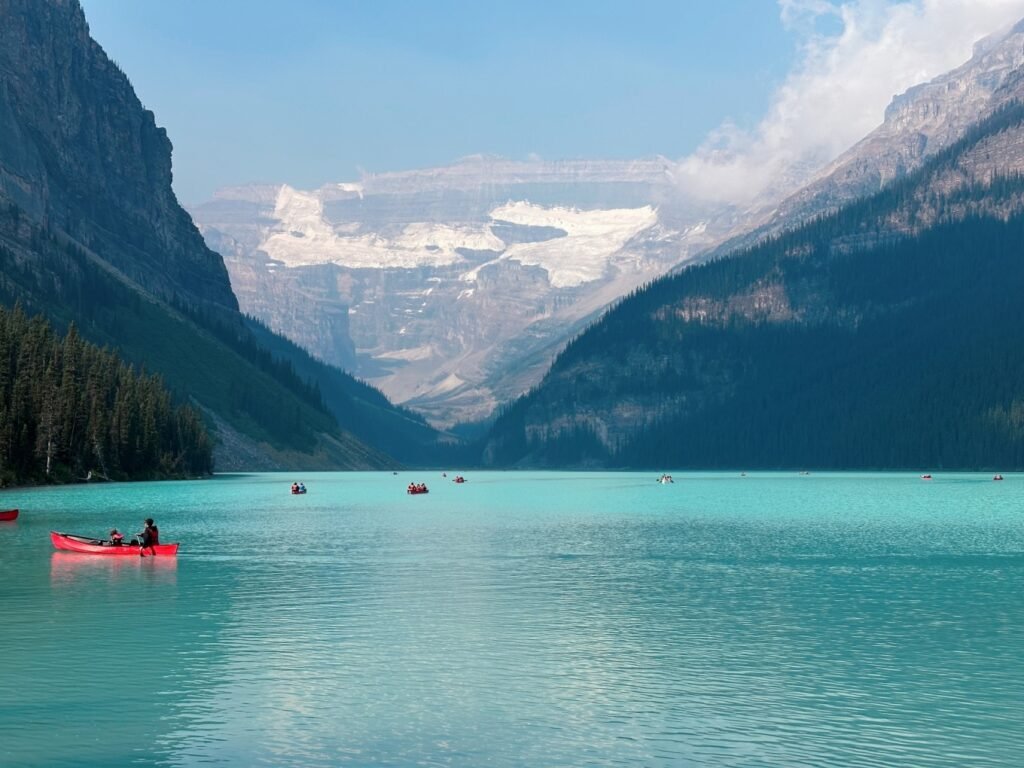
Emerald Lake
Emerald Lake, located in Yoho National Park, lives up to its name with its stunning gemstone-green waters. The scenery is absolutely top-notch! Visitors can hike the trail that circles the lake or rent a canoe to explore the waters.
It’s an ideal spot for an early morning visit to catch the sunrise or enjoy a peaceful hike along the lakeside trail. In the morning light, the emerald waters reflect the surrounding peaks, creating a scene straight out of a fairy tale. I loved the peaceful and tranquil atmosphere here — it’s a perfect place to unwind and connect with nature.

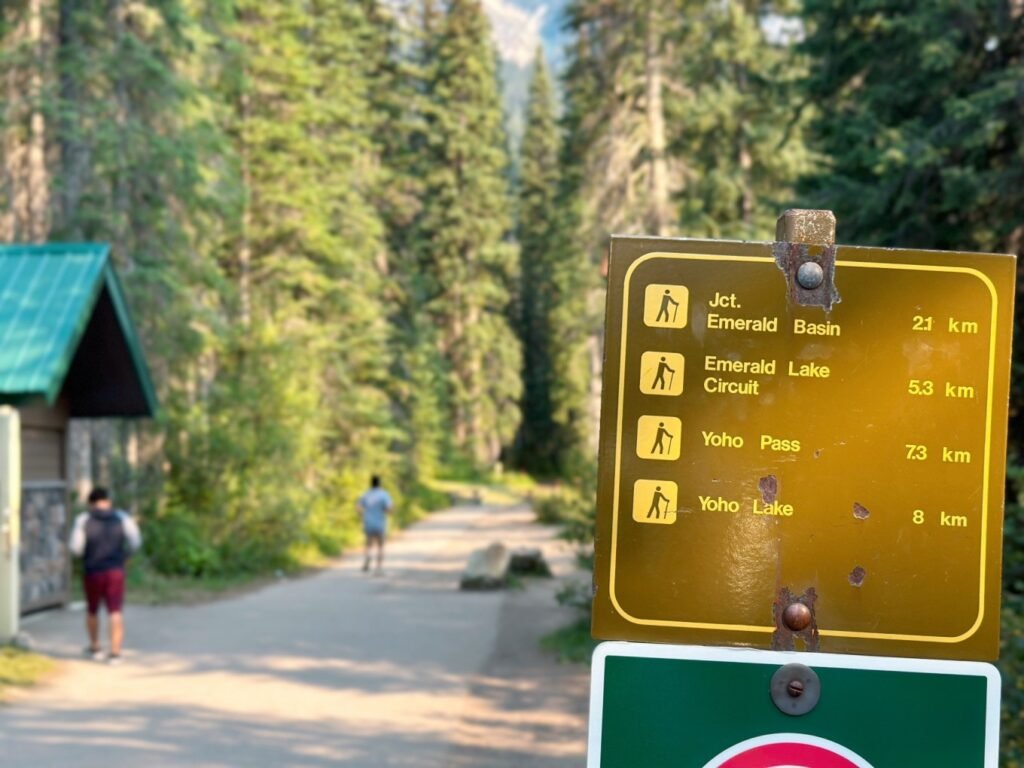
Natural Bridge
Natural Bridge is a naturally formed rock bridge, and it’s well worth spending some time here. The longer you explore the national parks, the more you marvel at nature’s incredible power—how water carved out such a massive gap through solid rock.
Visitors can stand right by the rushing stream to feel the full force of the water flowing beneath the bridge. The best time for photography is in the afternoon when the sunlight beautifully illuminates the Natural Bridge and the towering Mount Stephen in the background.

Field Town
Field is a quiet little town located right off Highway 1 and is a must-pass stop on the way from Emerald Lake to Banff. Surrounded by snow-capped mountains, it’s the perfect place to slow down and stay for a couple of days. On the way to the local restaurant, you’ll cross a busy railway, and from the restaurant’s parking lot platform, you can take in a panoramic view of the town.
One spot I highly recommend is Truffle Pigs Bistro & Lodge. Their signature burger with sweet potato fries and the duck breast pasta are both fantastic choices — you can’t go wrong with either. The sauce and vegetables in the burger are perfectly balanced, while the duck breast in the pasta is tender yet pleasantly chewy, with a touch of saltiness that adds to the flavor.
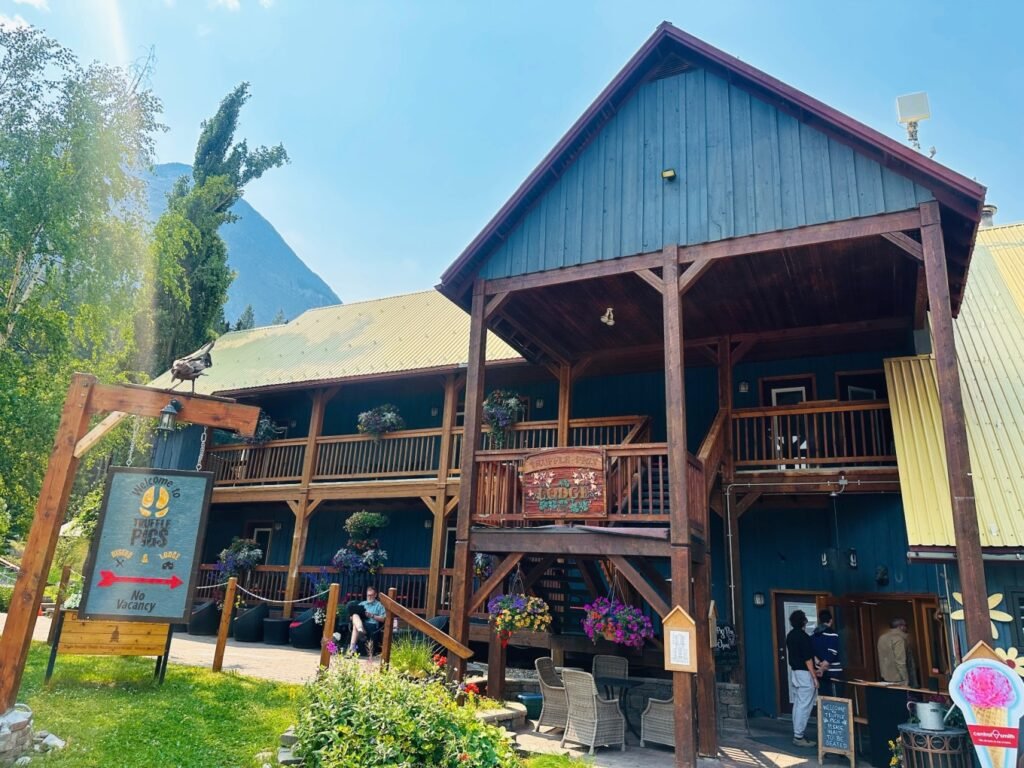
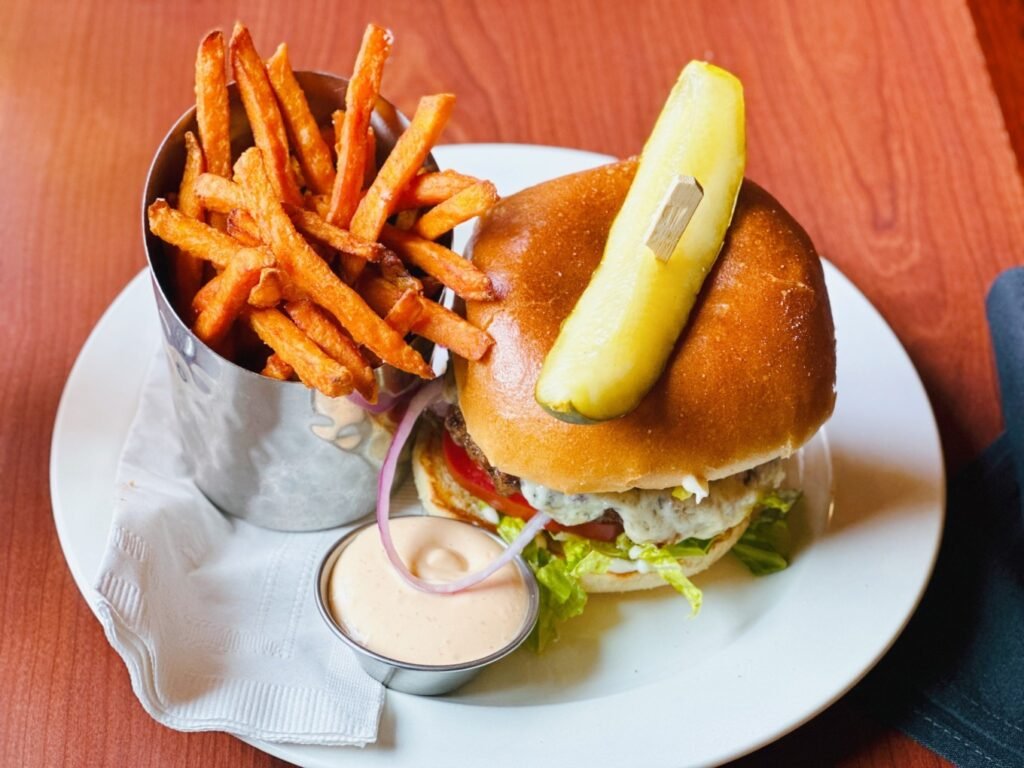
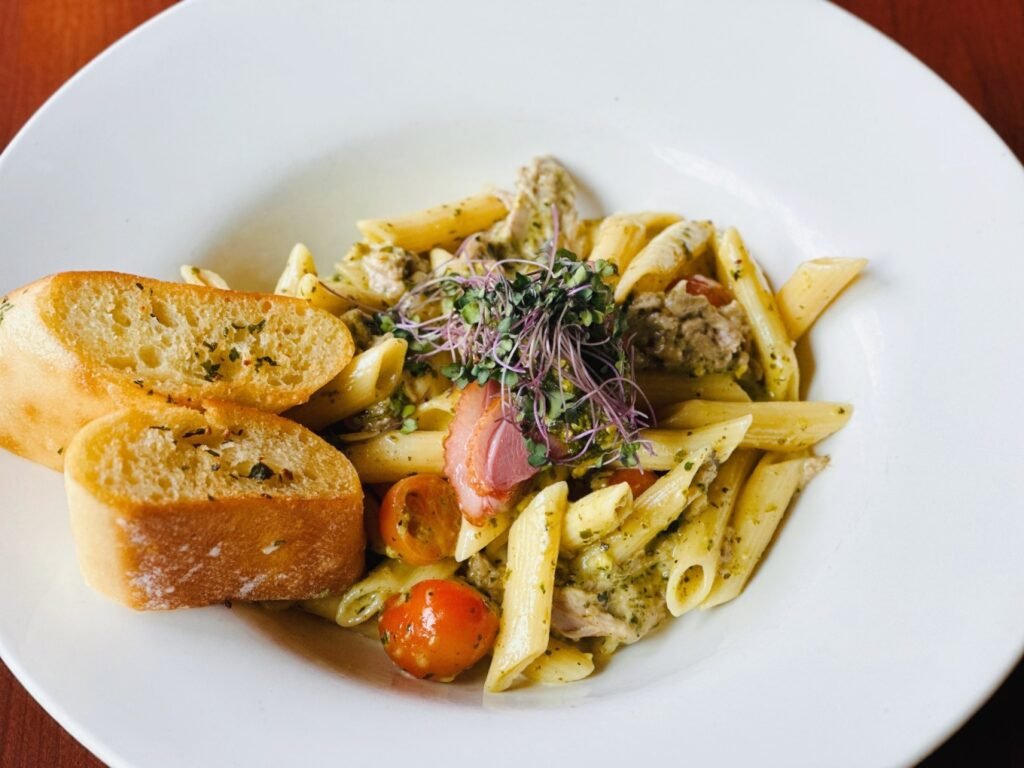
Canmore | A Charming Artsy Town
After leaving Yoho, we drove straight to Canmore. Nestled right next to Banff, Canmore offers a quieter, more peaceful vibe compared to its lively neighbor. This picturesque, storybook town exudes charm, with its cozy wooden cabins beautifully framed by the majestic mountain backdrop.
Canmore’s slower pace and serene atmosphere make it easy to fall in love at first sight. It’s the perfect place to unwind, with an artistic flair that adds to its unique character. Whether strolling through town or simply enjoying the views, Canmore has a special magic that’s hard to resist.
Like other tourist towns, Canmore is filled with charming craft shops, cozy cafes, pubs, and restaurants. What sets it apart is the perfect balance between commerce and nature. While there are plenty of excited visitors like me, most of the people you’ll encounter are locals going about their everyday lives.
This sense of “just right” makes Canmore feel truly special. It’s a place that touches the heart with its warmth and gentle simplicity, leaving a lasting impression.
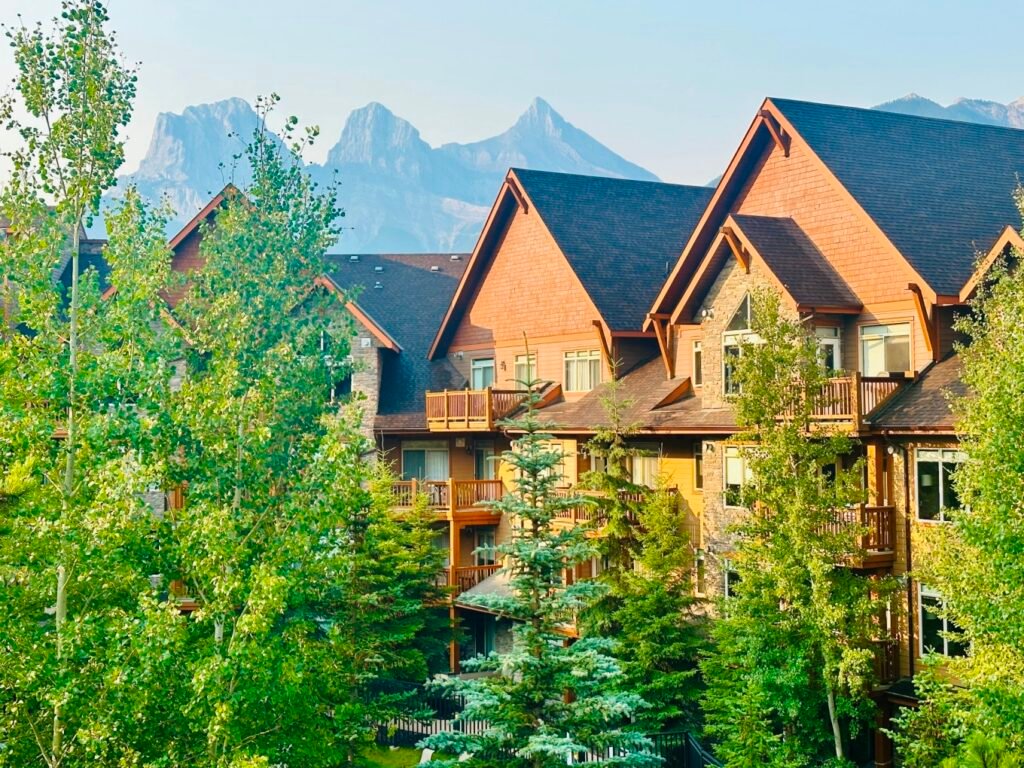
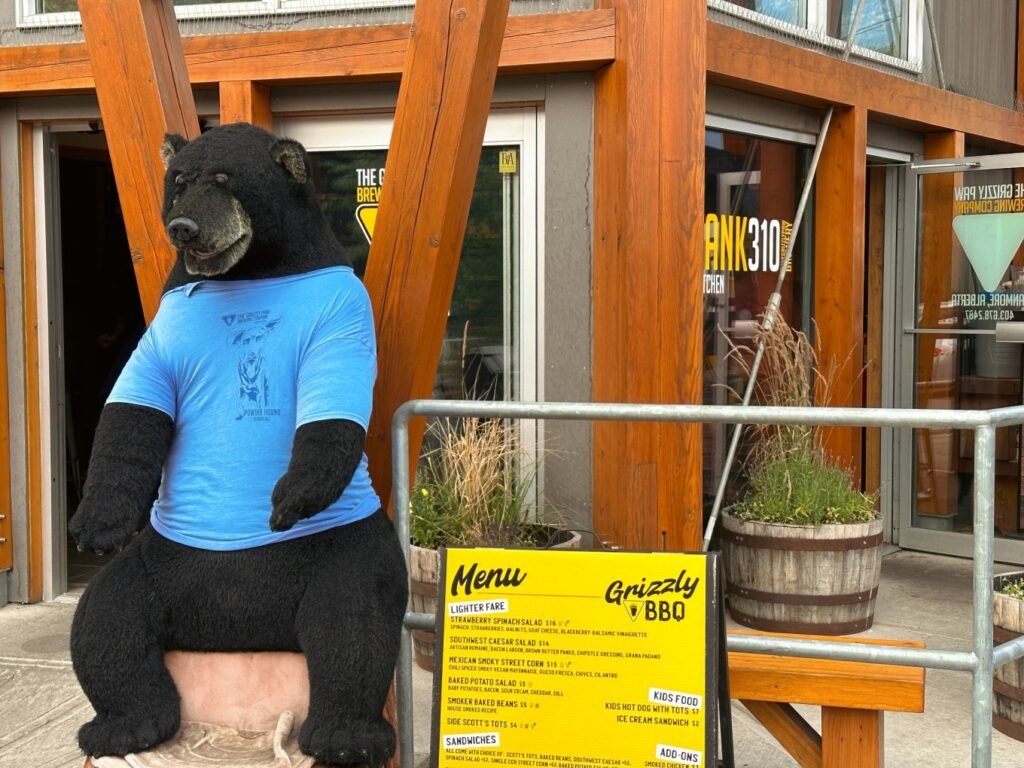
Banff Gondola & Sulphur Mountain
After breakfast, we made our way through Banff town to the gondola parking lot. We arrived 45 minutes earlier than our scheduled time, but after some discussion with the staff, they kindly adjusted our reservation to give us extra time to enjoy the views atop Sulphur Mountain.
The Banff Gondola ride takes about eight minutes to reach the summit of Sulphur Mountain. From the observation deck, you get breathtaking panoramic views of Banff, the surrounding mountains, rivers, and valleys.
We were incredibly lucky — not only was the weather perfect, but just as we reached the viewpoint, we spotted three massive bighorn sheep lazily lounging nearby. They were so still for at least ten minutes that we joked the scene looked like a paused video.
Sulphur Mountain is a destination that offers something in every season. Even in summer, the winds are strong and it can get chilly at the top, so wearing long sleeves is a good idea. Pro tip: Book your gondola tickets online in advance to secure your preferred times for the ride up and down.
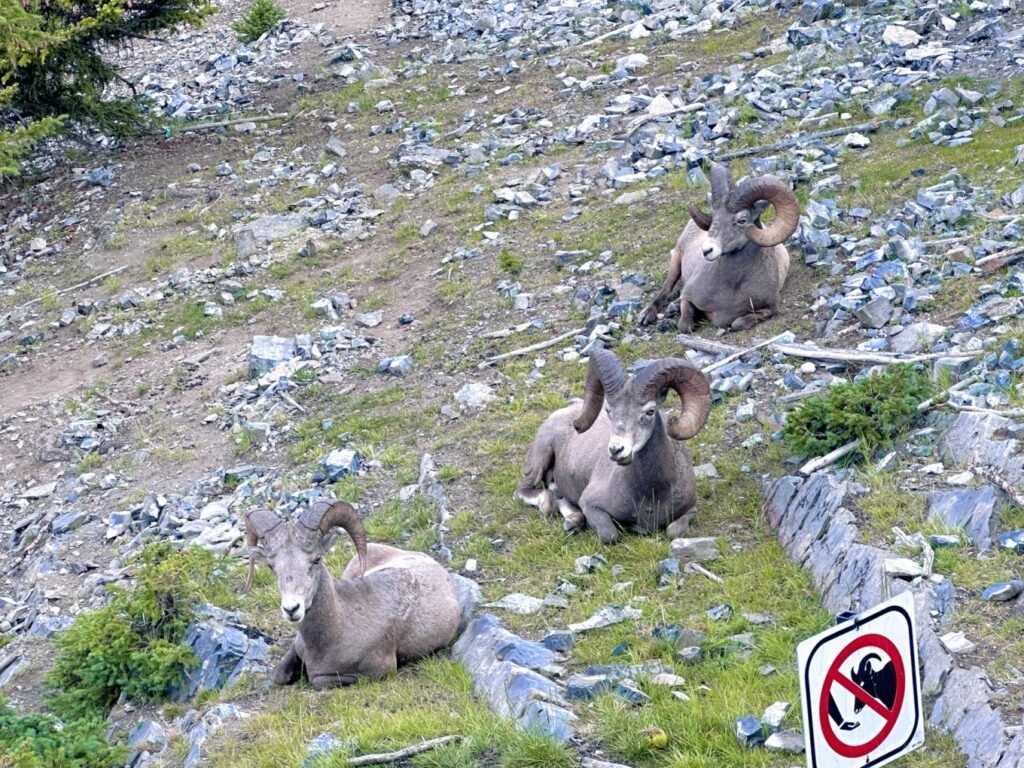
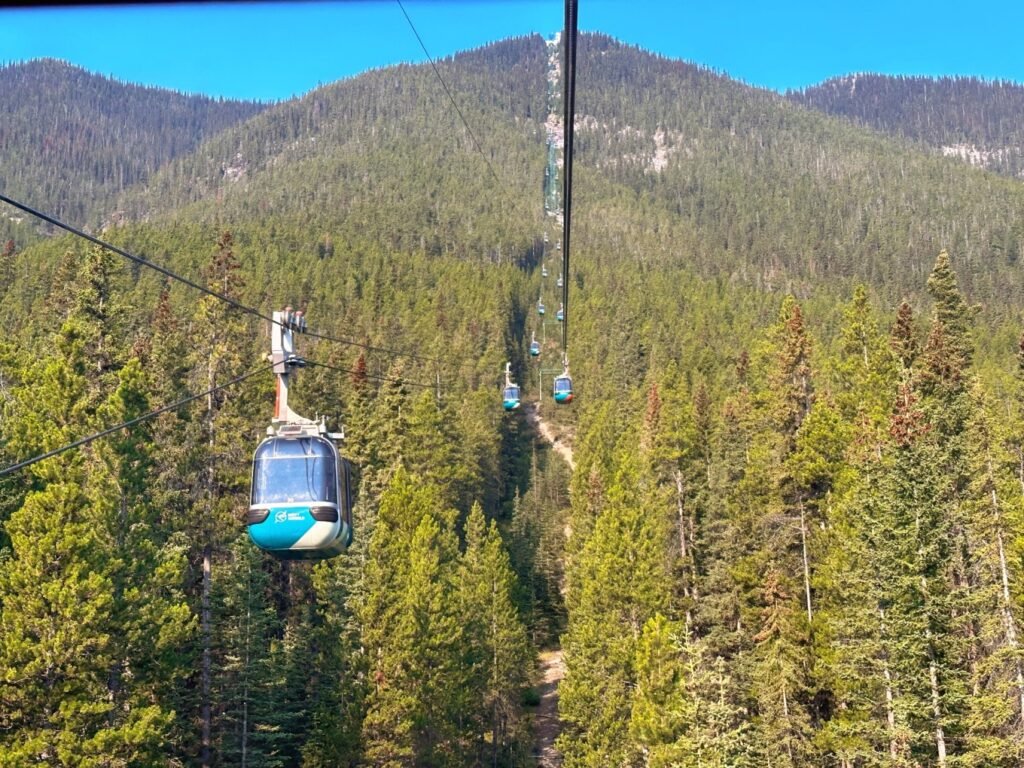
Lake Minnewanka
Lake Minnewanka is the largest and deepest lake in Banff National Park, located in a beautiful valley and also known as the “Water Spirit.” Because the lake is very long and narrow, only a small part can be seen from the shore. The best way to explore it is by taking a sightseeing boat. There are water activities and a marina by the lake (boat tickets are included in the national park pass; we booked the 4:30 PM tour, hoping to catch the sunset on the lake, but unfortunately, we encountered one of the few rainy days of our trip, which was a bit disappointing).
During the 90-minute boat tour, a professional guide provided commentary, and we enjoyed a fun ride on the boomer boat, appreciating the beautiful scenery and learning about the local wildlife and ecosystem. It seems that a scene from the movie The Revenant was filmed here when Lake Minnewanka was covered in snow.
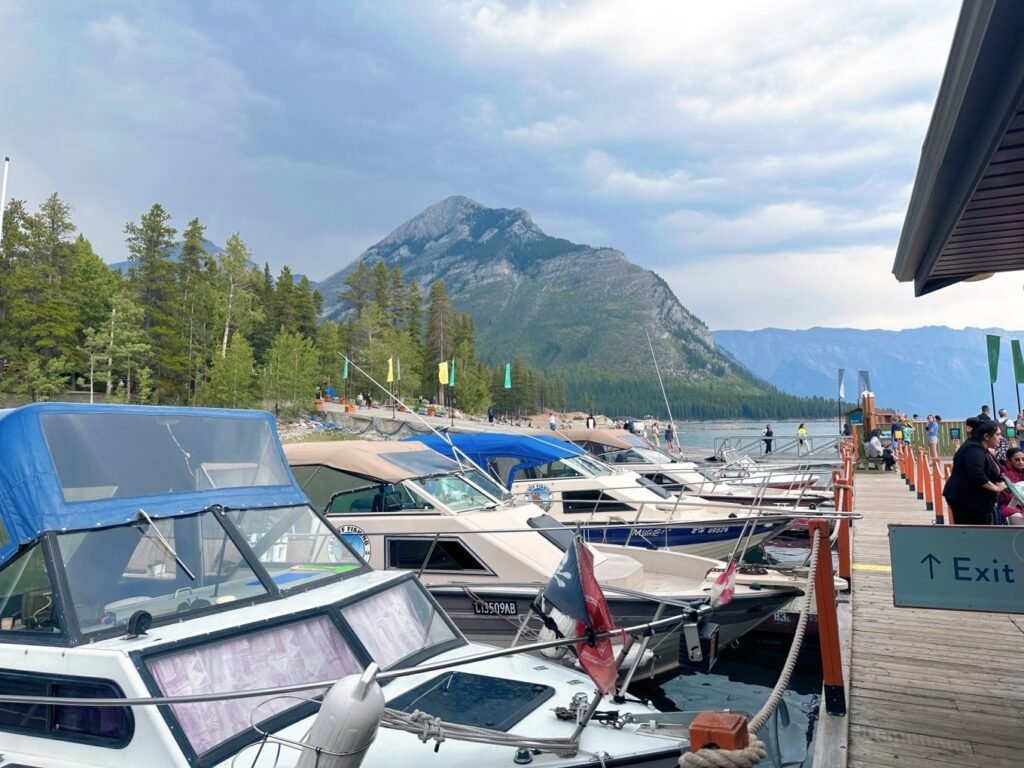

Calgary | One of the World’s Most Livable Cities
Calgary, also known as “Cowtown,” is a city in southern Alberta, Canada, located near the Rocky Mountains. It serves as the economic, financial, and cultural hub of the province. Calgary has repeatedly been recognized as one of the cleanest cities in the world and has ranked fifth among the most livable cities globally for several years, according to The Economist.


